This is the third and last segment of the way in of my summer vacation. The name of Yogyakarta, the focal point of tourism in the east of Java island, is derived from Ajodhya, the Indian city which is supposedly the birthplace of Rama, the central character in the Ramayana epic.
CDG - NRT : Air France (Boeing 777-300ER) Sunrise
NRT - DPS : Garuda Indonesia (Boeing 777-300ER) The island of Gods
DPS - JOG : Garuda Indonesia (Boeing 737-800) The city of the Ramayana (You are here)
JOG - SUB : Sriwijaya Air (Boeing 737-800) A zero height volcano (English version to be posted)
MLG- DPS : Wings Air (ATR72-600) The sulfur volcano (English version to be posted)
DPS – ICN : Garuda Indonesia (Airbus 330-300) The calm of the morning (English version to be posted)
ICN – CDG : Korean Air (Airbus 380-800) Bad flight (English version to be posted)
The DPS domestic terminal in DPS has been installed in the former international terminal. The check-in counters are simple, and each is dedicated to a specific flight. We see here the counters for the flights to JOG, SUB, and one of the flights to JKT.
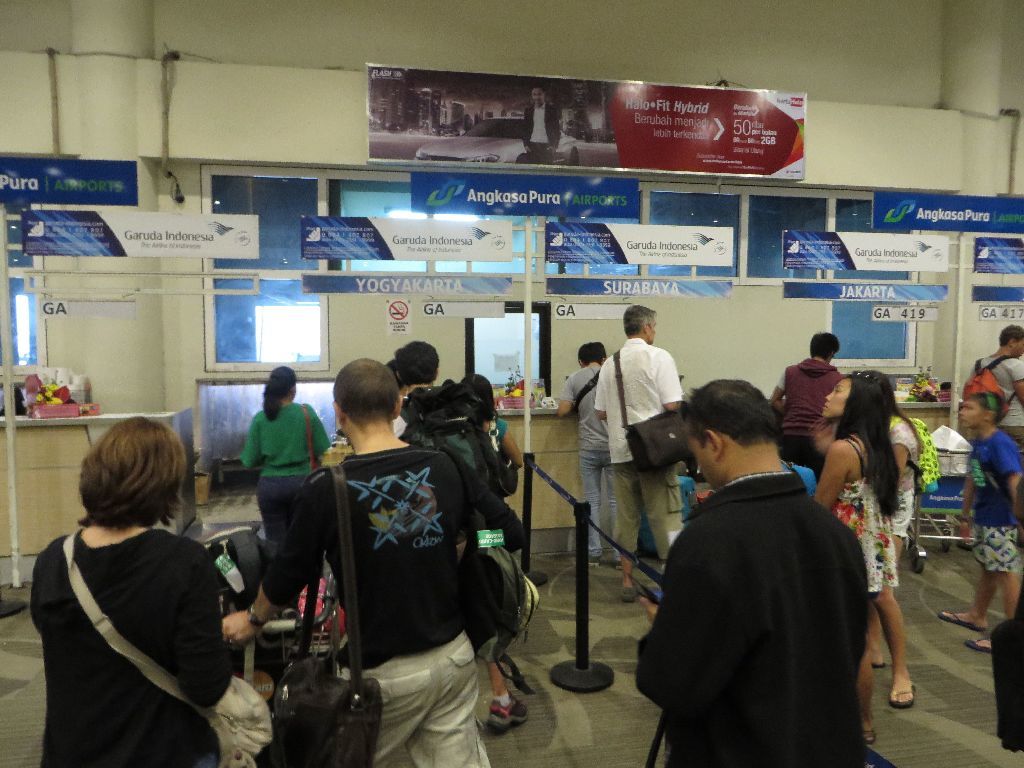
The staff seemed surprised not to find the luggage tags of the previous flights (I had removed them as I usually do in order to keep them as souvenirs), but that did not create a problem and the luggage which was tagged for the third time were put next to this window which provides a direct access to the tarmac.
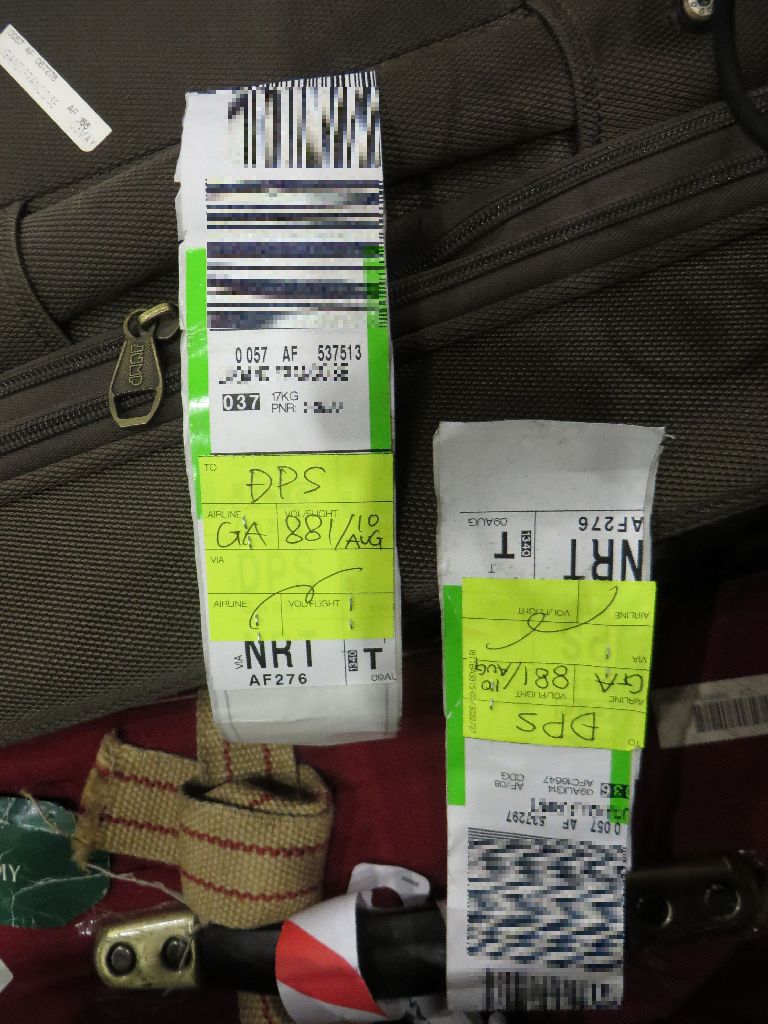
There is no conveyor belt, and no sorting, since each counter processes a single flight at a time.
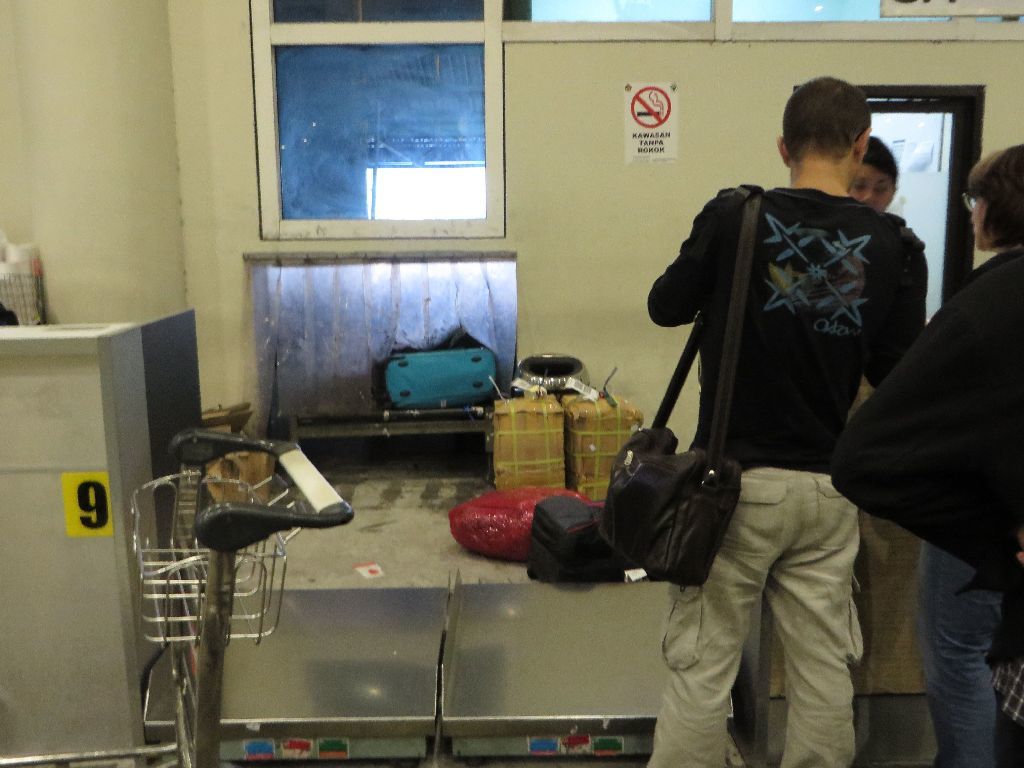
We go through the security check. We did not have to pay the airport tax, since it is included in the price of Garuda's domestic flight tickets (but, oddly enough, not in that of their international flights).
It will soon be night, very quickly so since DPS is very close to the equator, and light is already insufficient to have a decent picture of the taxiing QR A330.
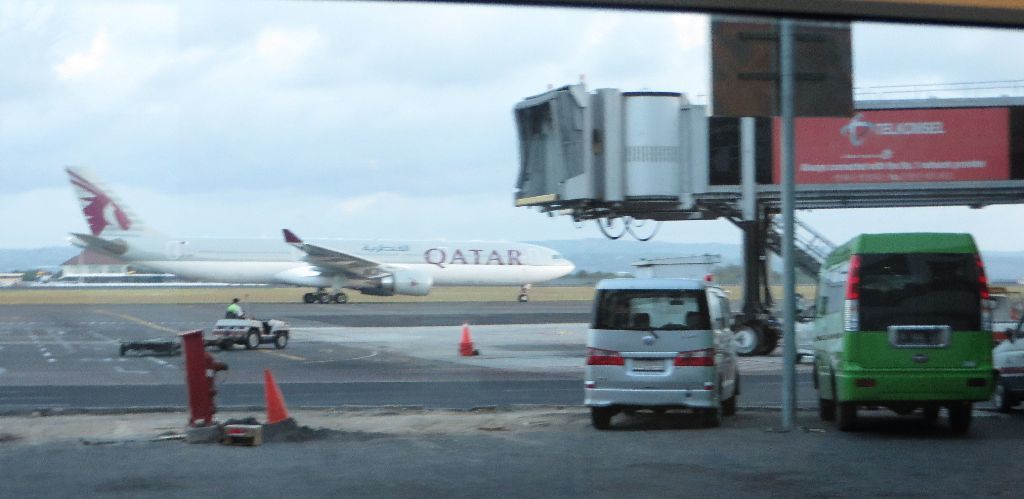
I can still make if the aircraft is motionless.
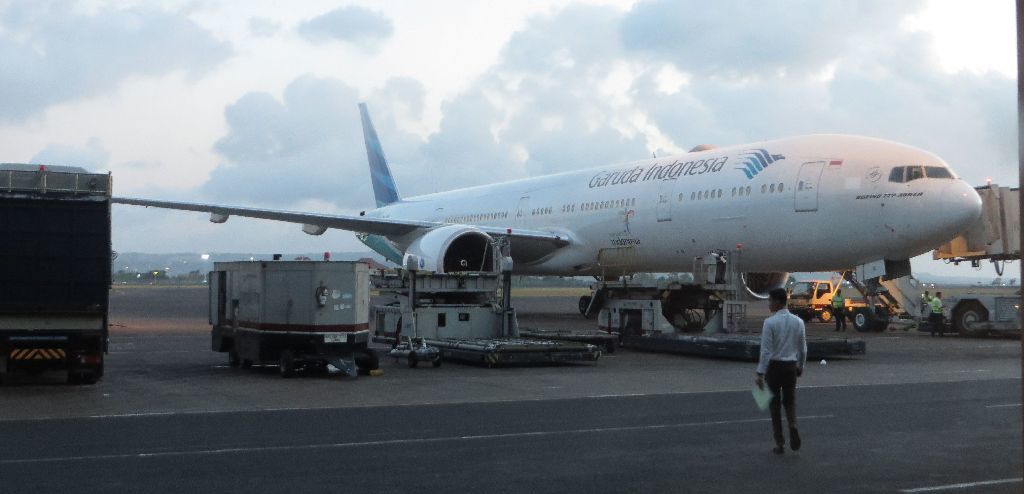
The airside part of DPS's domestic terminal is not luxurious, and the view on the tarmac is all the more limited that we are at ground level.
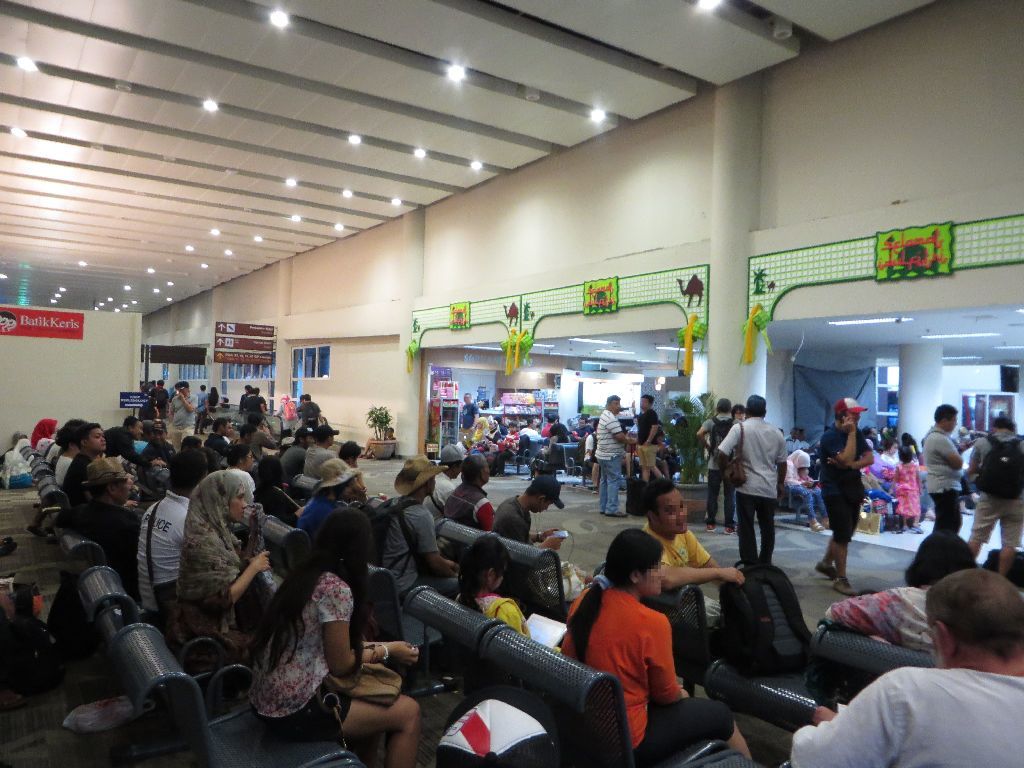
It is relatively crowded, but we found two seats side by side, next to our boarding gate.
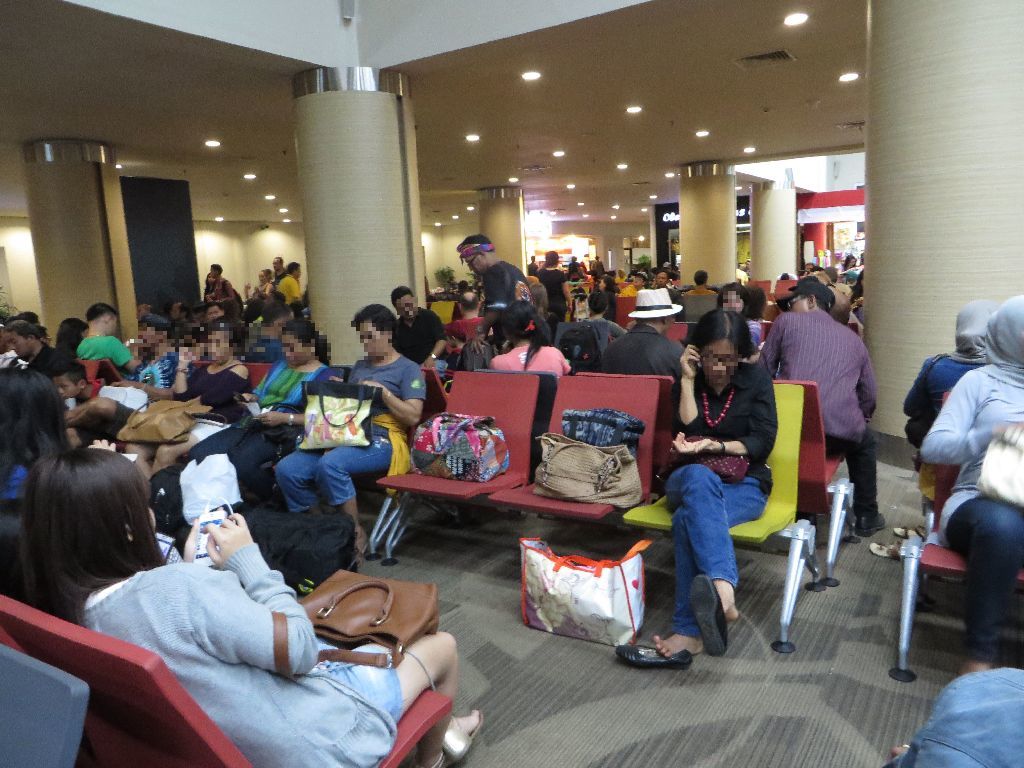
And there is a free wifi network, not very fast, but good enough to display the current corporate screen.
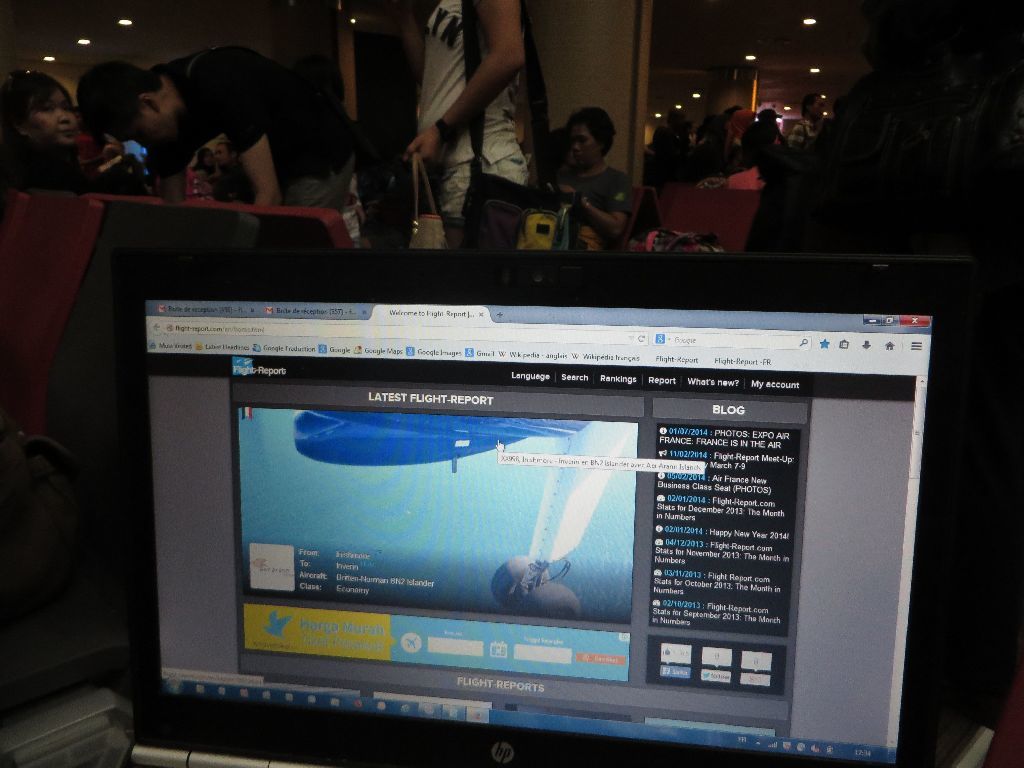
It is now pitch dark outside.

A ceiling decoration
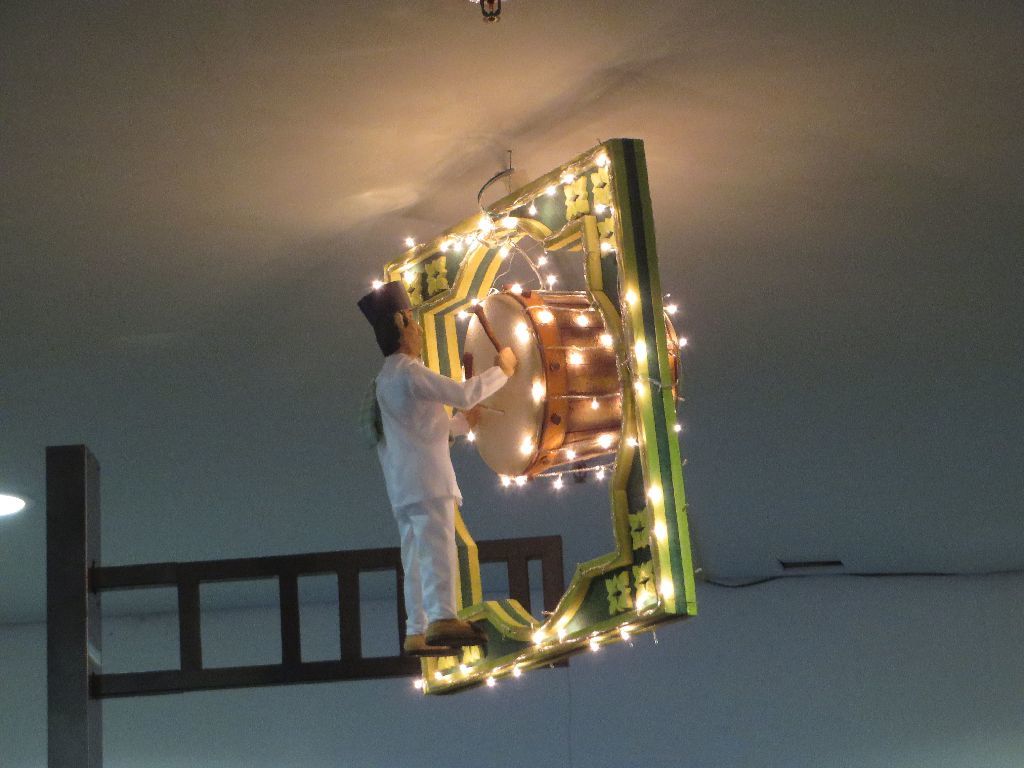
Boarding of flight GA225 was supposed to be at gate 20, but it will be gate 19 (no big deal, since they are a few meters from each other), and the staff made a mistake when he posted the flight number. A Western passenger corrects himself light GA552 into flight GA255. Meanwhile, Mrs. Marathon improves her karma by calling back French tourists who forget their camera on their seat. All that in a good humored and friendly mood.
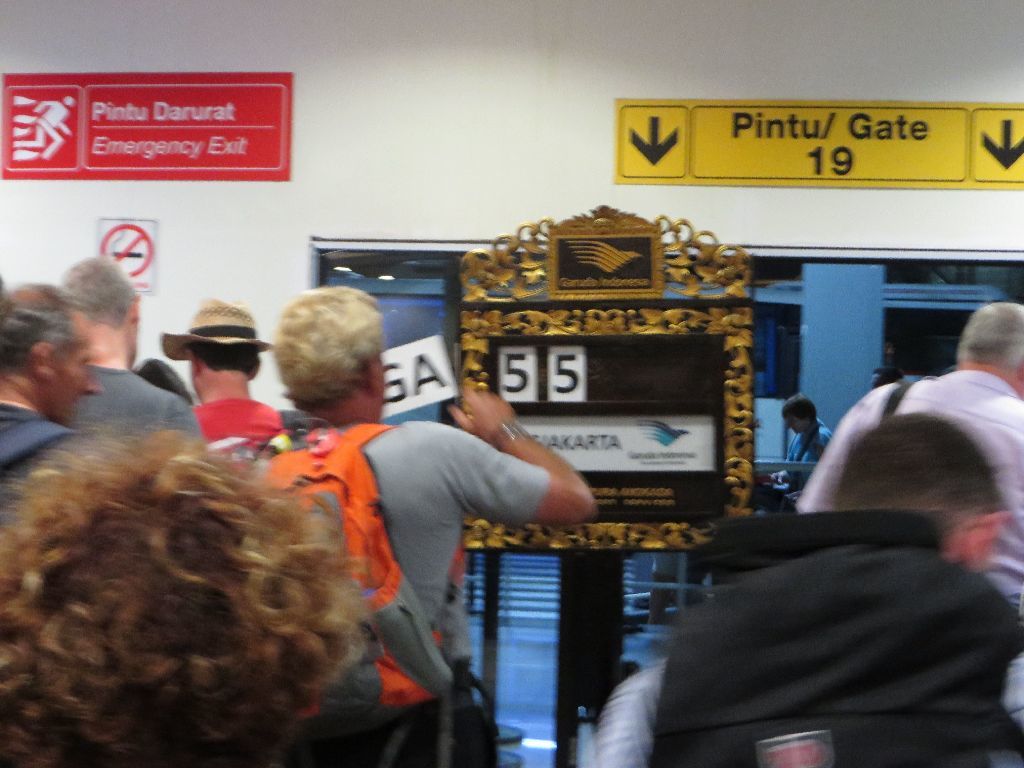
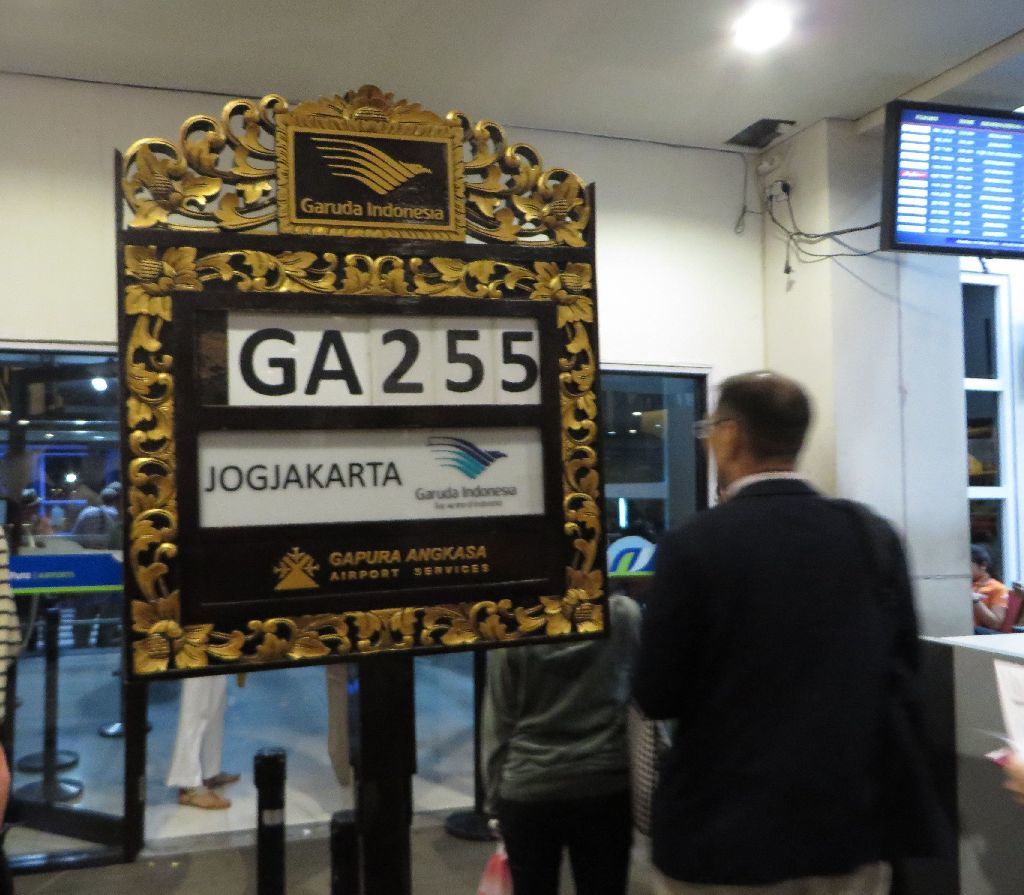
There is no priority, no jostling, and it is of course a bus transfer.
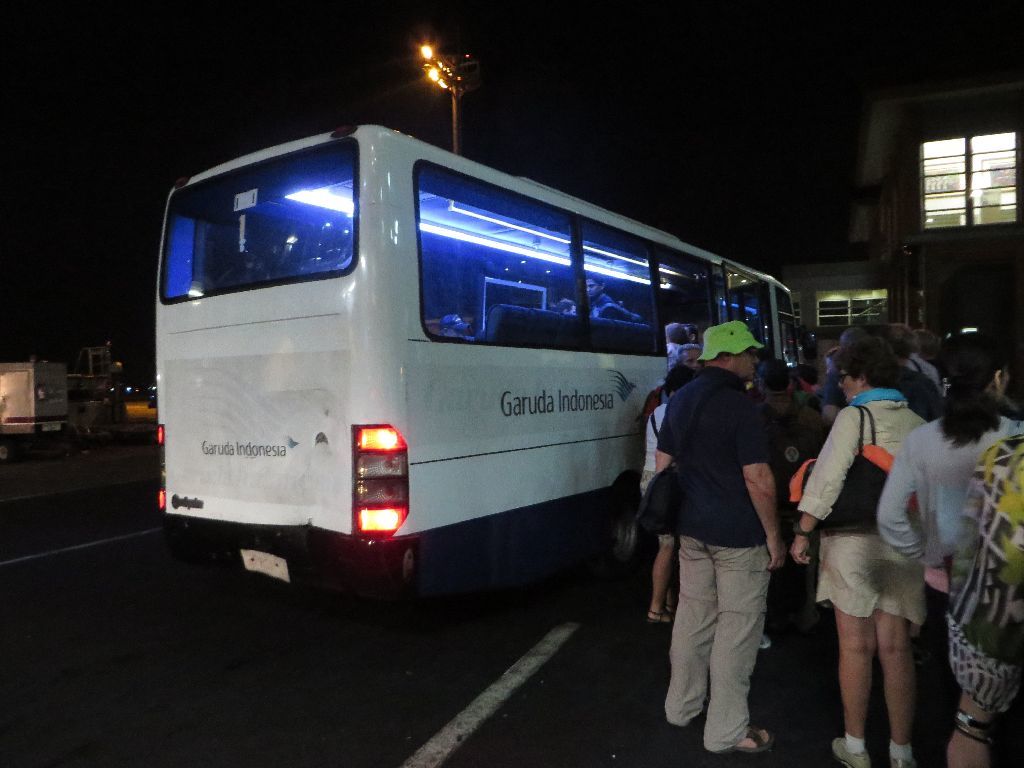
… to this 738, that we board from both ends according to the row number.
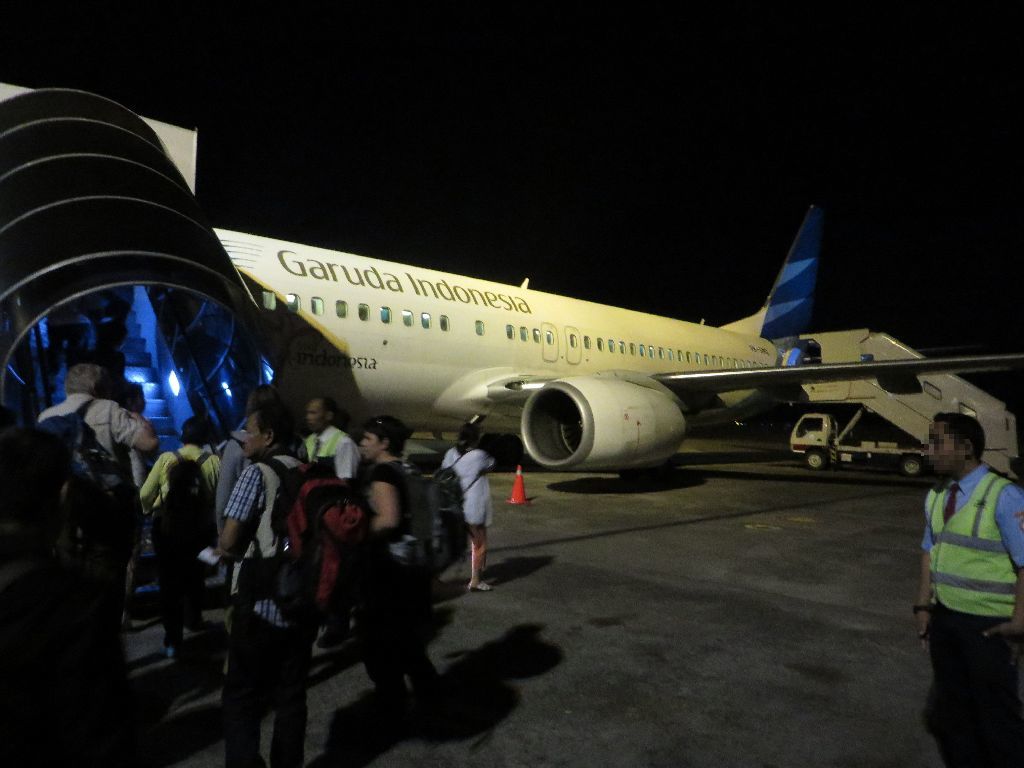
It is not posted very clearly; but the time I have taken all the pictures I wanted for this report, it is too late to call back my wife who boards erroneously by the front stairs. No big deal, since our seats are close to the central emergency exits.
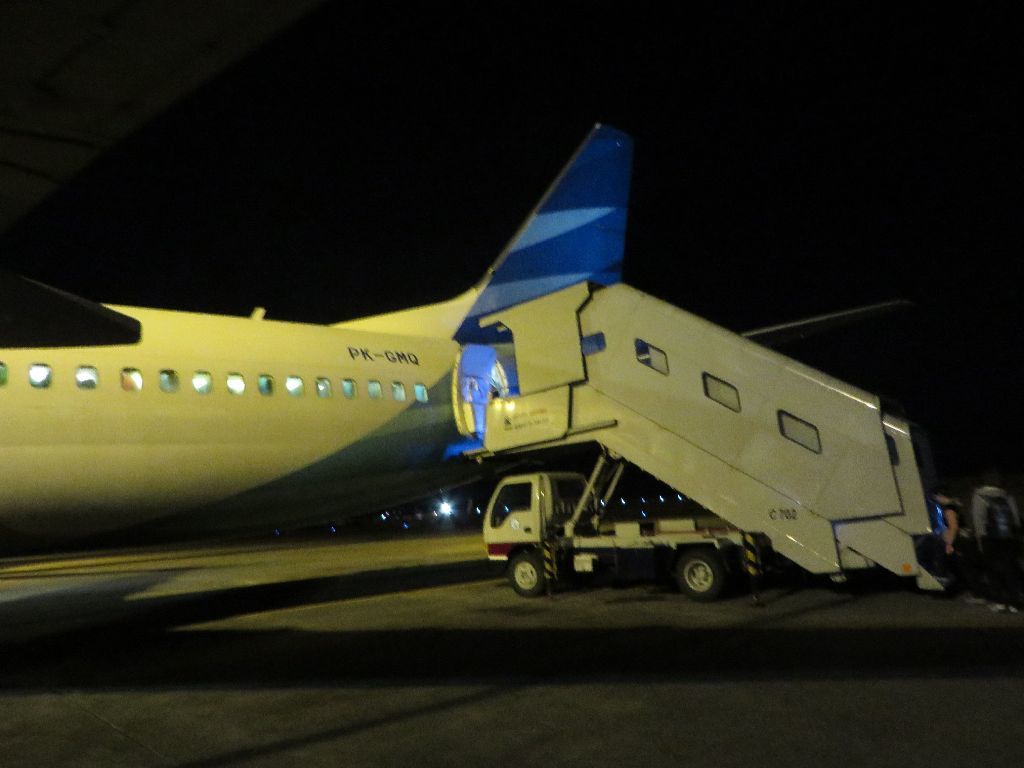
For registration number geeks, PK-GMQ started commercial operation on September 3rd, 2010
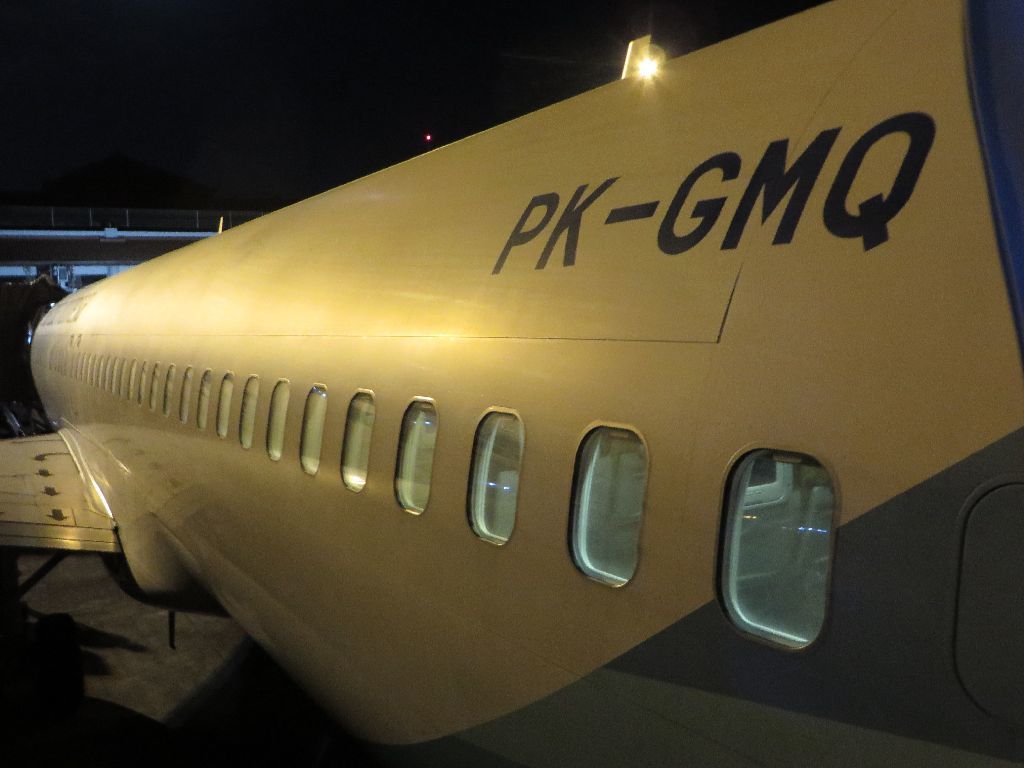
… and the cabin is of course quite new.
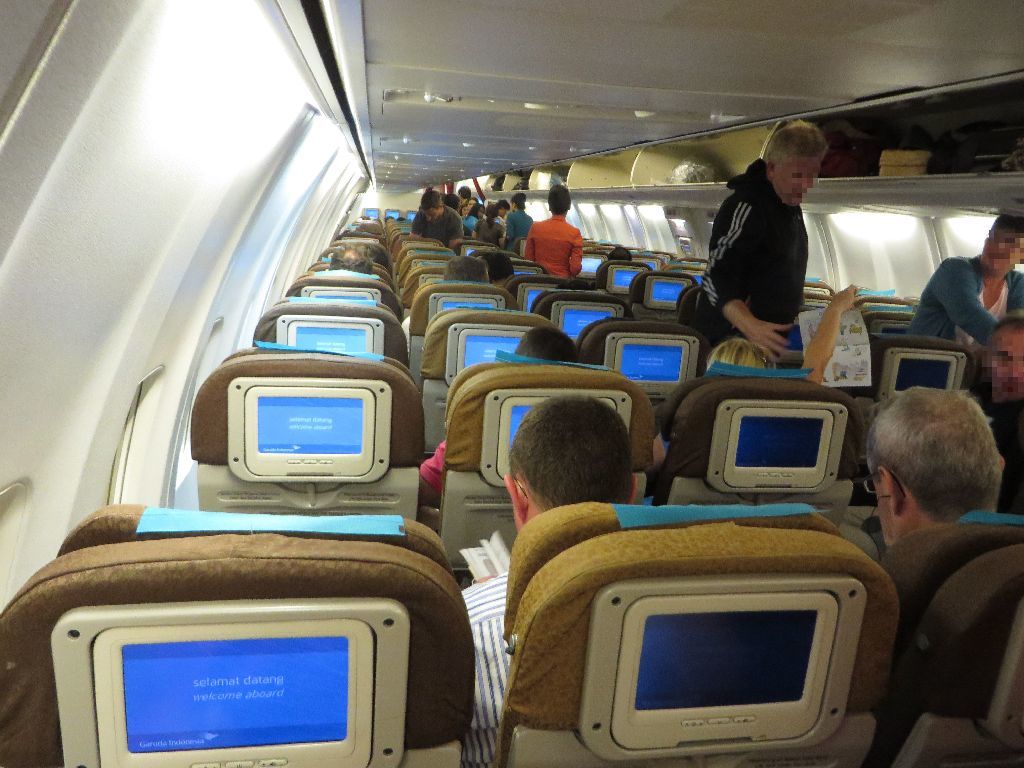
All 737s in the world have a 3+3 layout in economy, and there cannot be any surprise with regards to seat width. Note that this means a solid centimeter wider than AF's 77W on a long haul flight.
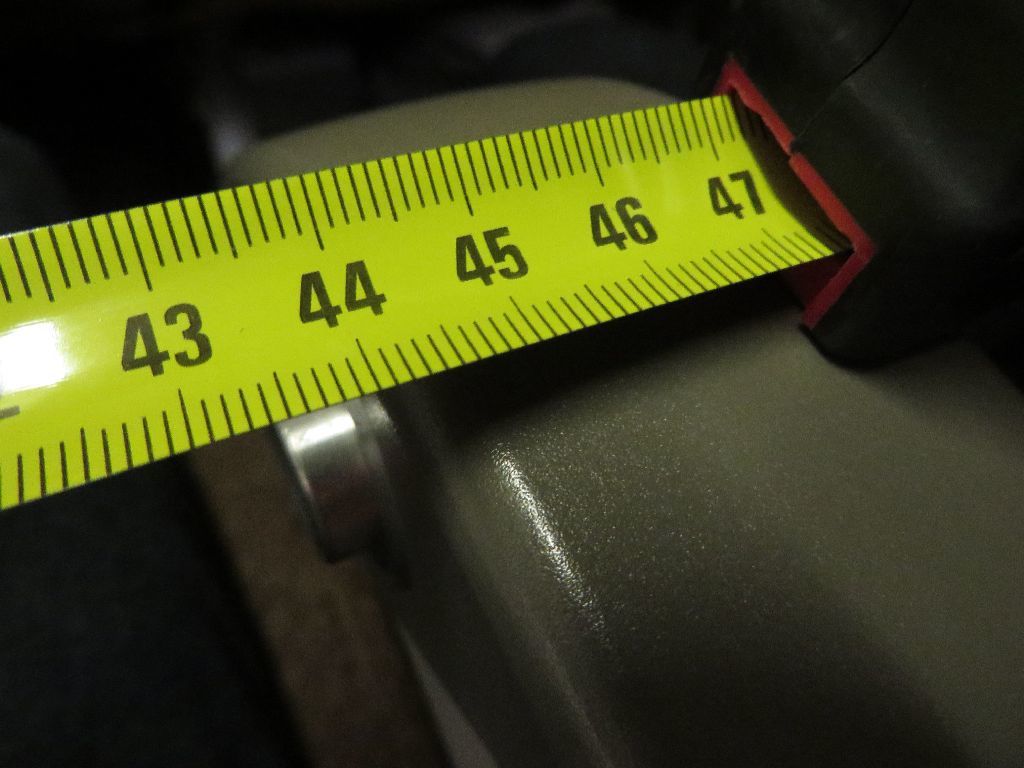
The seat pitch is OK too
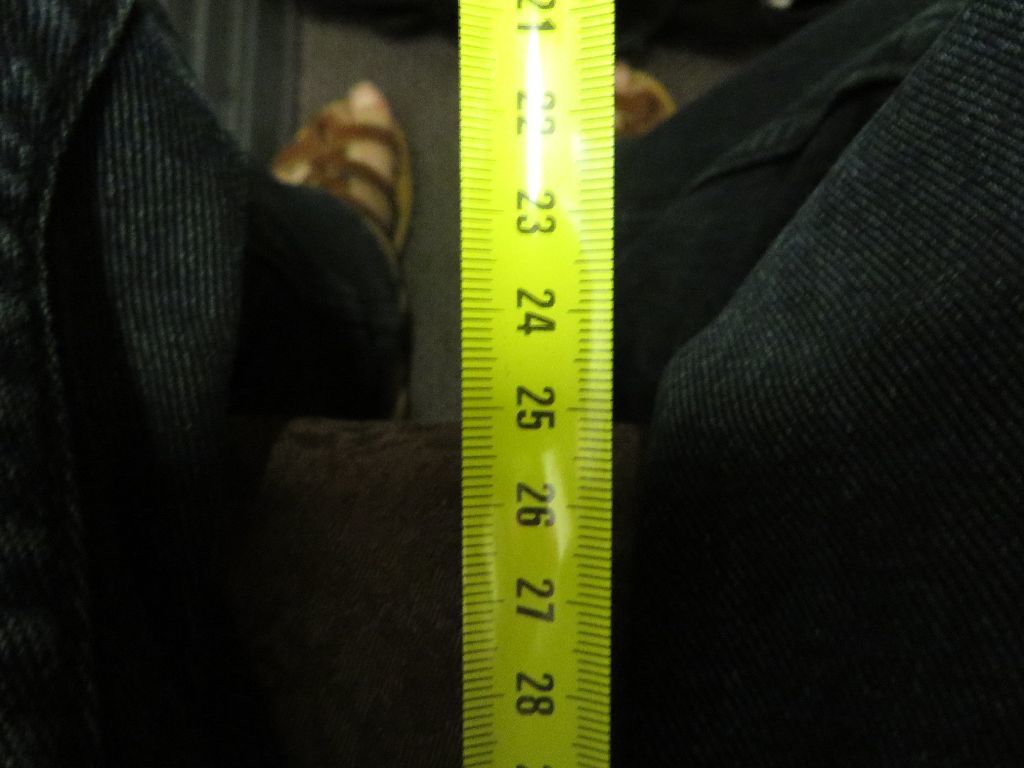
The seat includes an IFE. The quality is good
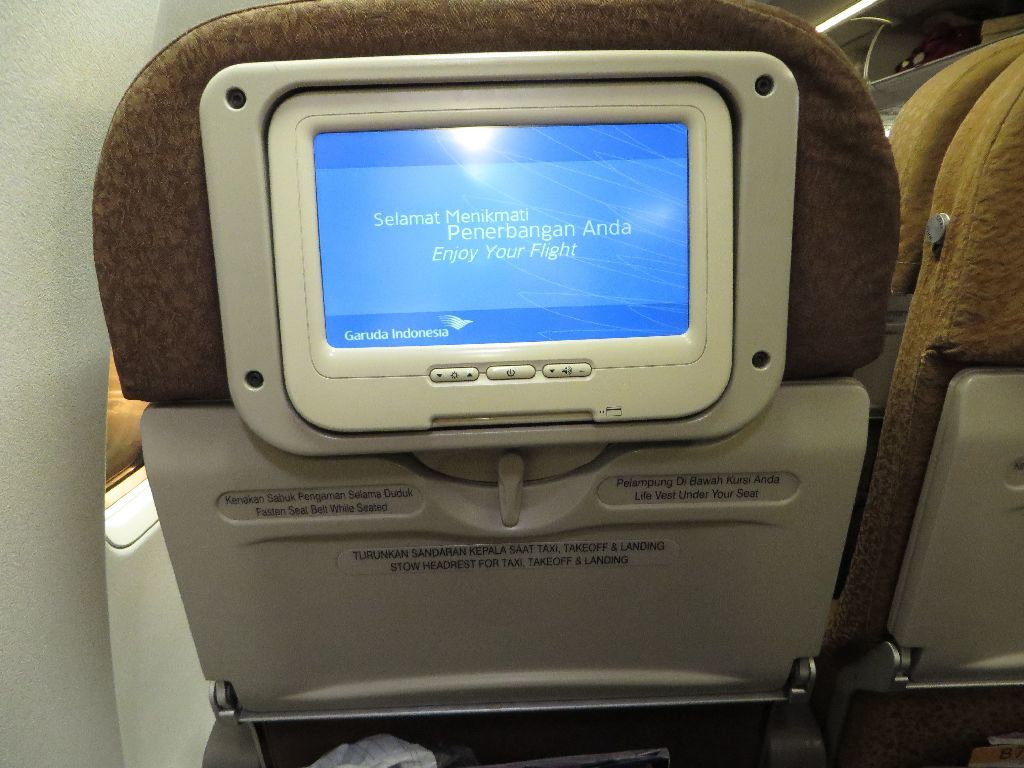
… and so is the size
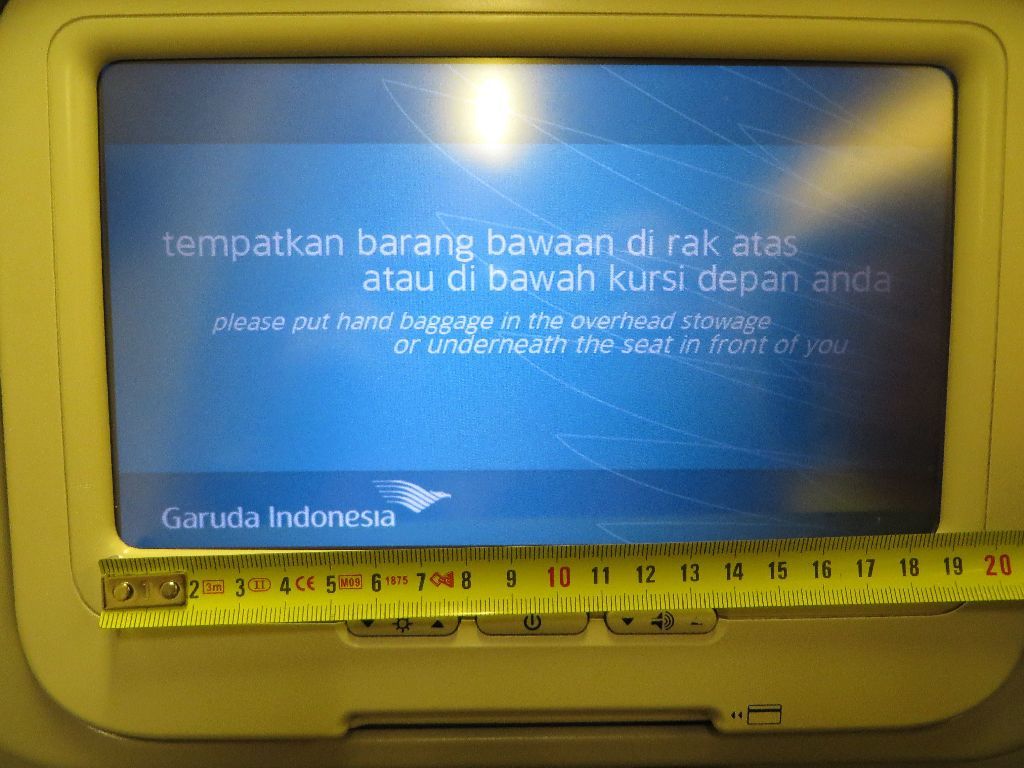
The safety demonstration is on the IFE (FAs show the emergency exits, though, and they of course delivered the standard information to passengers seated there), in Indonesian and English, subtitled in simplified Chinese.
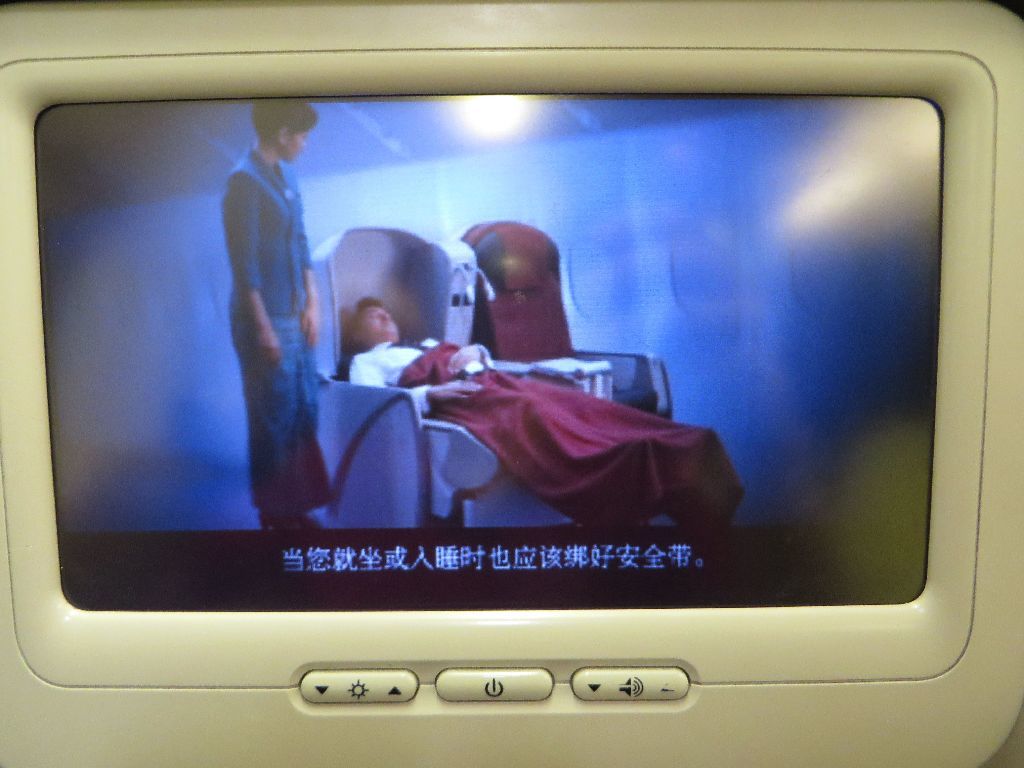
The safety card, both sides
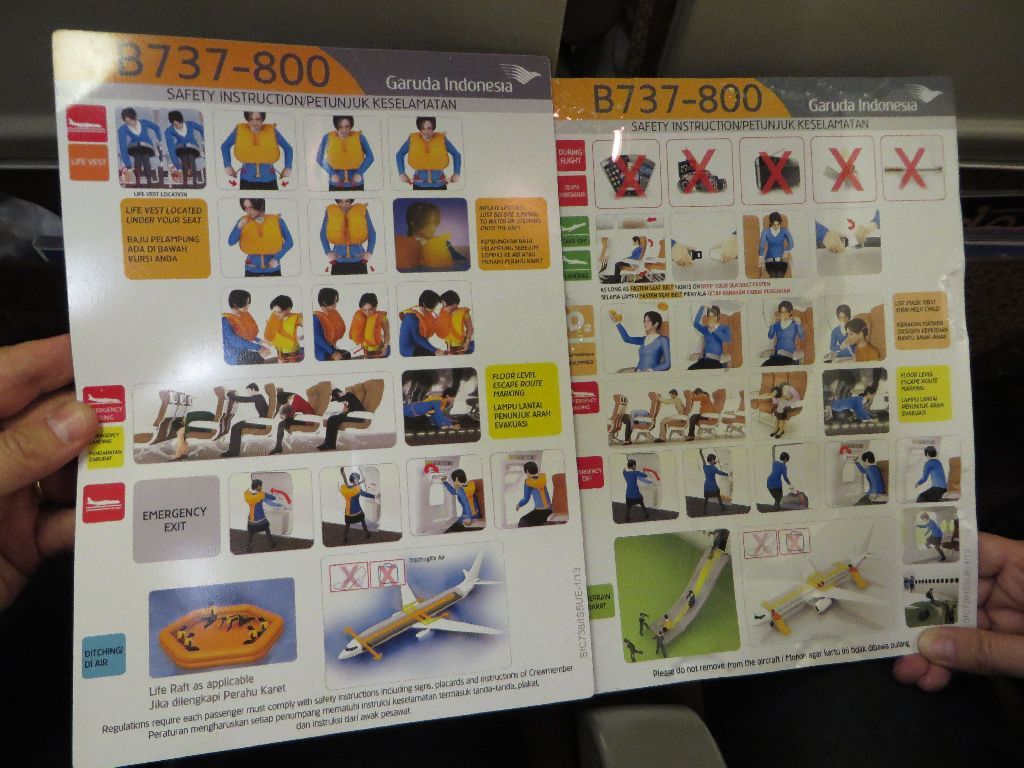
The plane takes off from Runway 09 about twenty minutes late and makes a U turn, but there is not enough public lighting to show you aerial views of Bali. I would need a more sensitive camera for that.
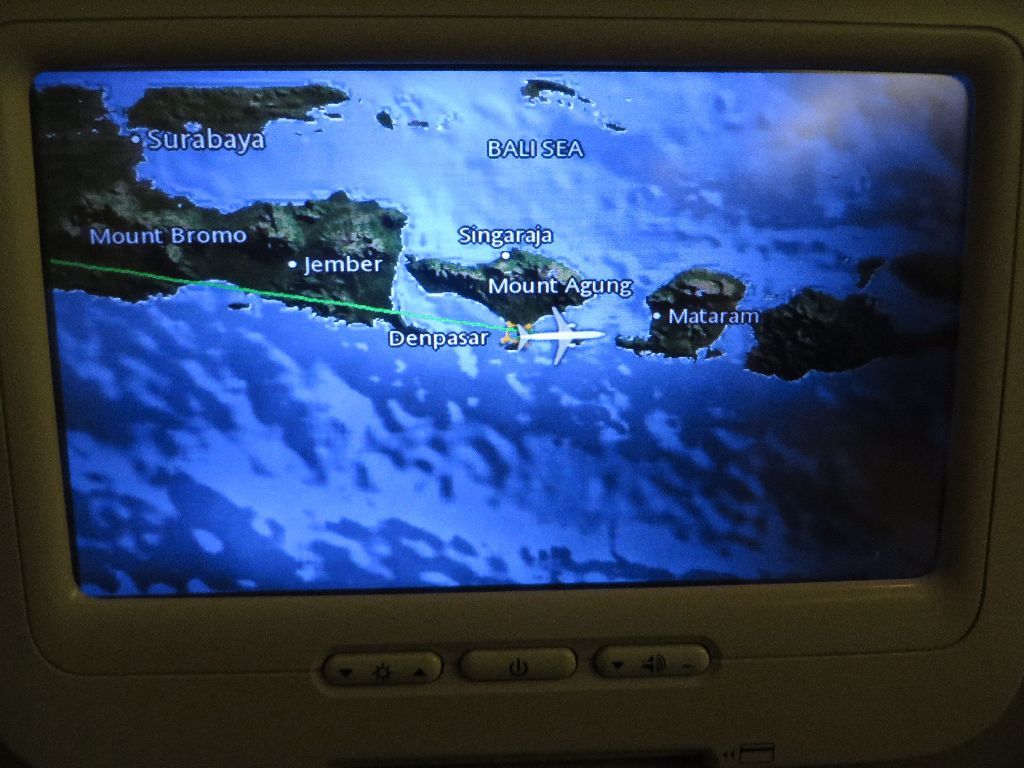
Catering is distributed in this cardboard box
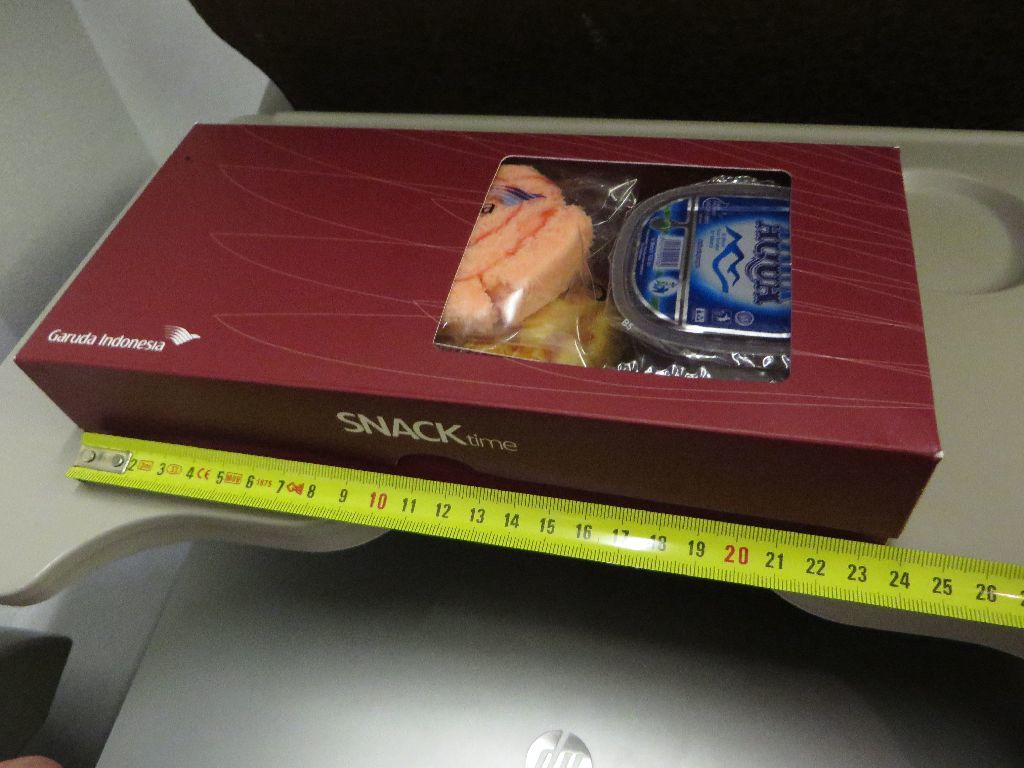
This is the content: this is not high level gastronomy, but it is much more than a cookie. Since our departure from CDG, we would only eat the food served on the three successive flights: it would be slightly not enough, but we would be too tired when we eventually make it to the hotel to go and have some dinner.
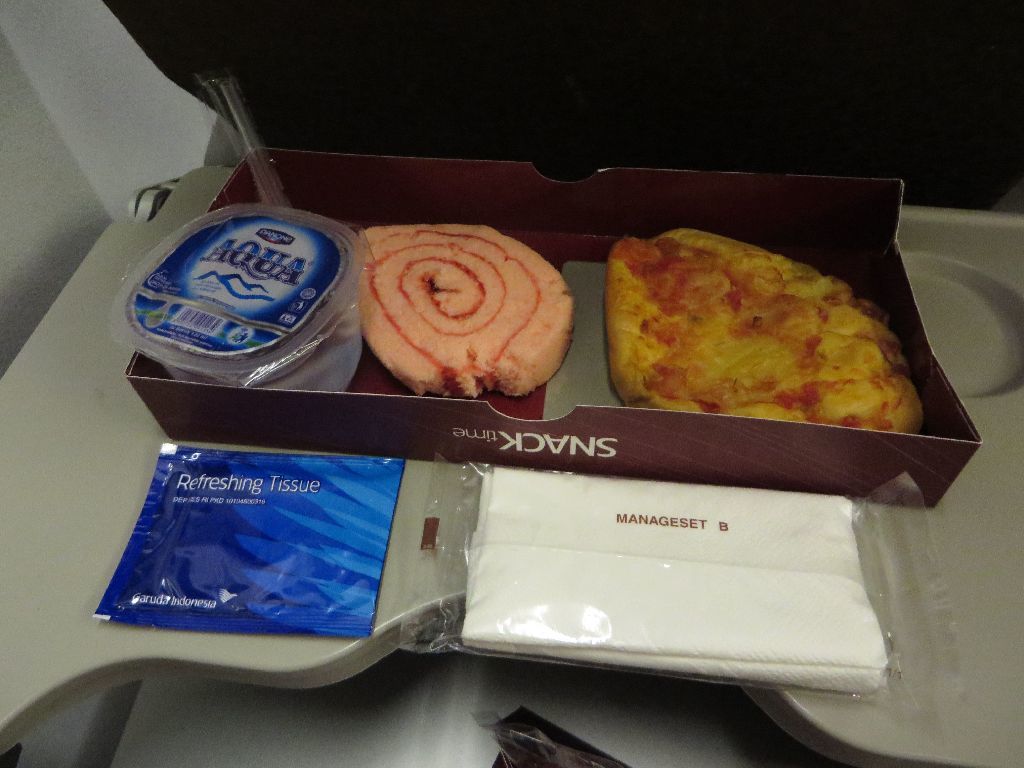
The remote control of the tactile IFE in the armrest
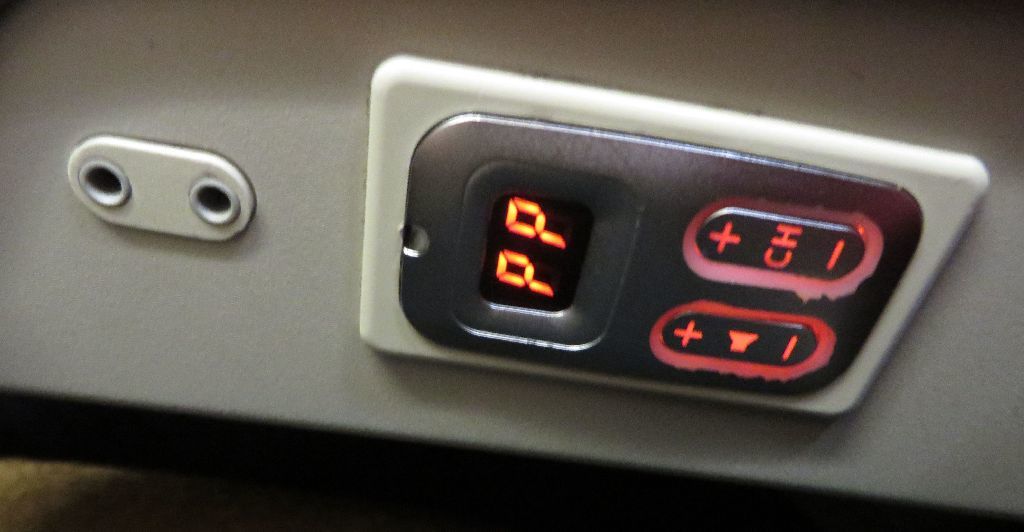
There are two screens of menus of non-religious music:
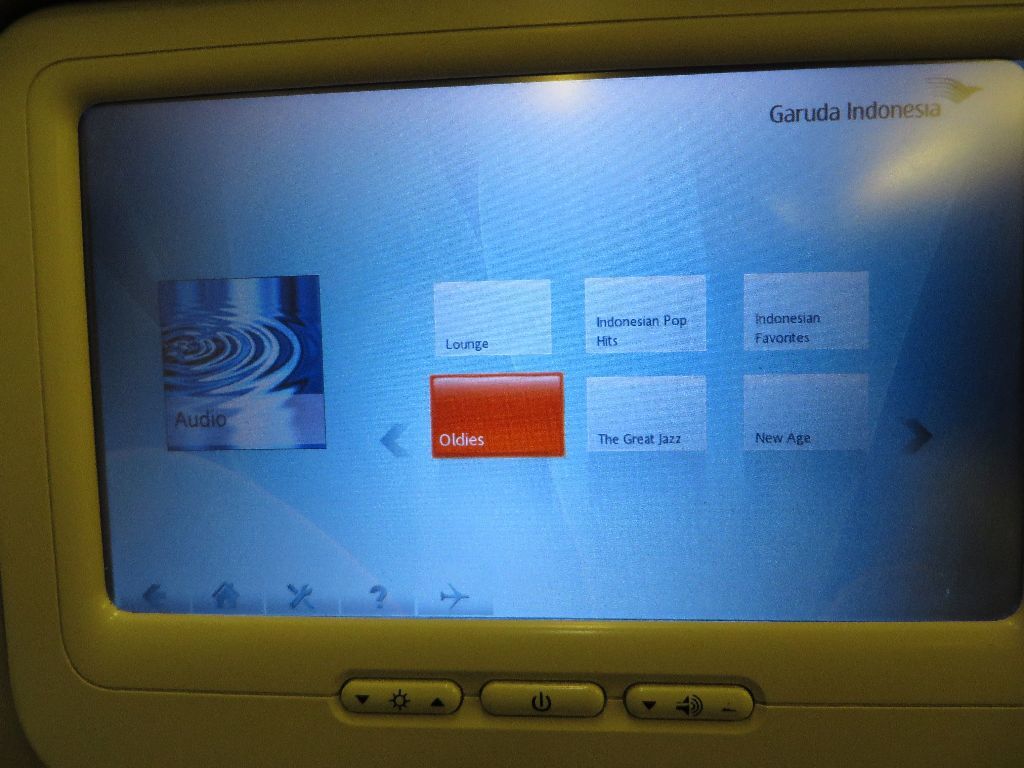
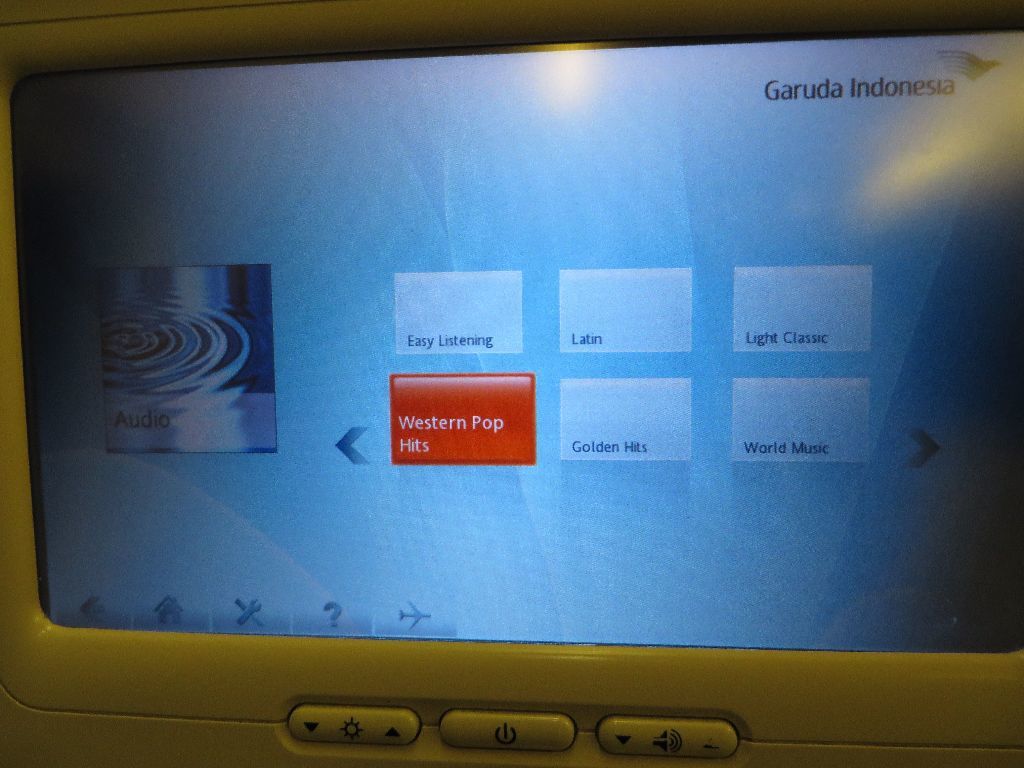
… and the Quran – I did not explore the menu in order to determine if it is available in languages other than Arabic.
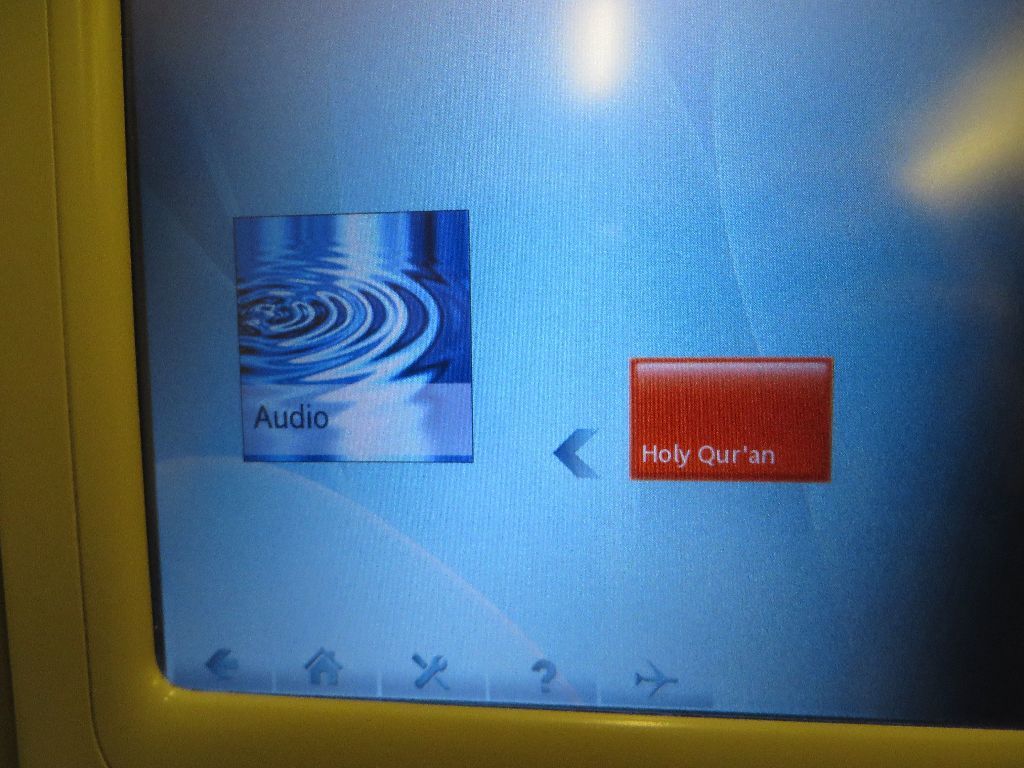
The headphones are of course of low quality (the coffee is average).
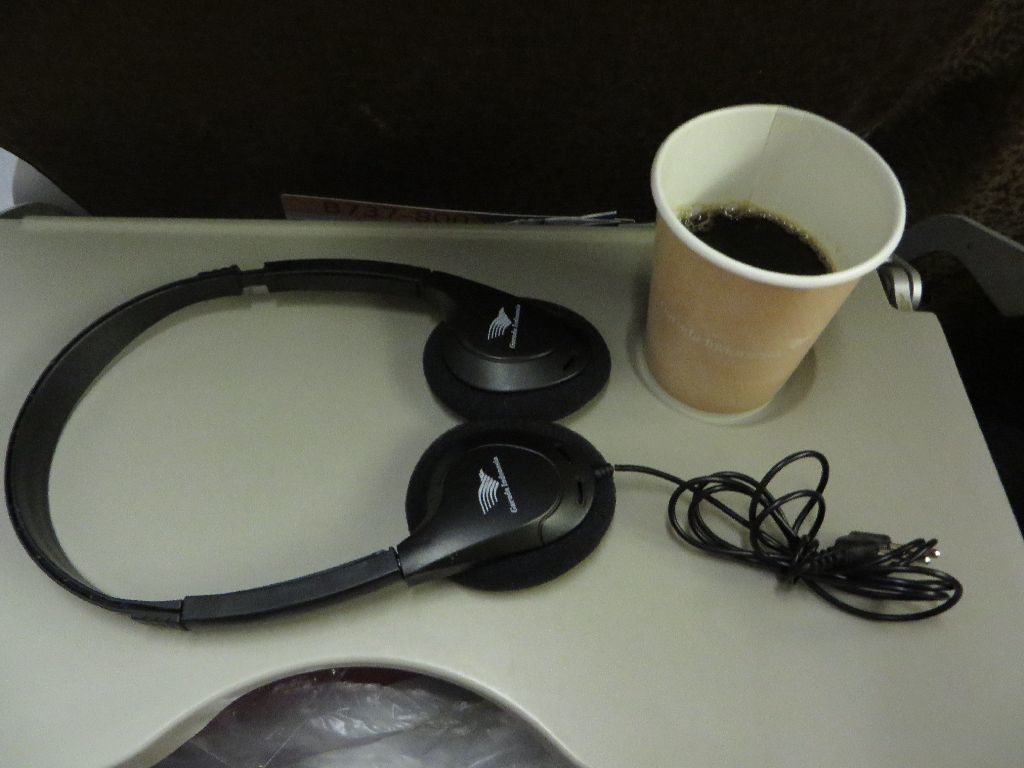
The headphones' quality is so poor, open to the outside noise and of course non noise suppressing, that I have difficulties hearing the Bartoli, singing a rather uninteresting mix of works.
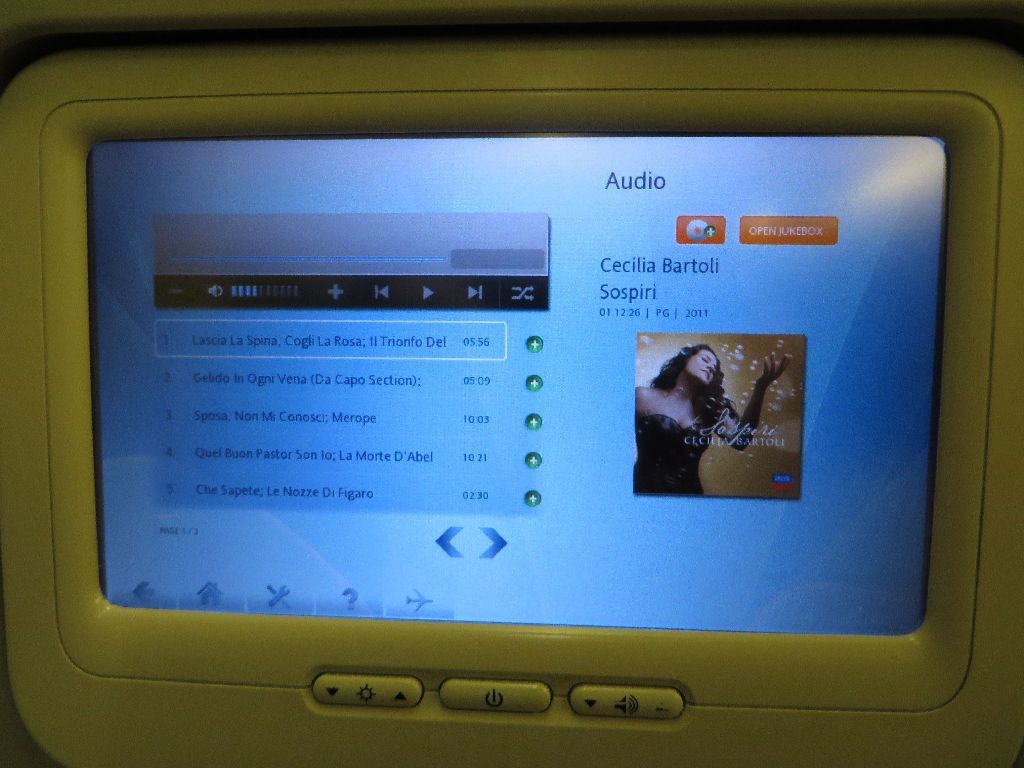
The seats recline a little
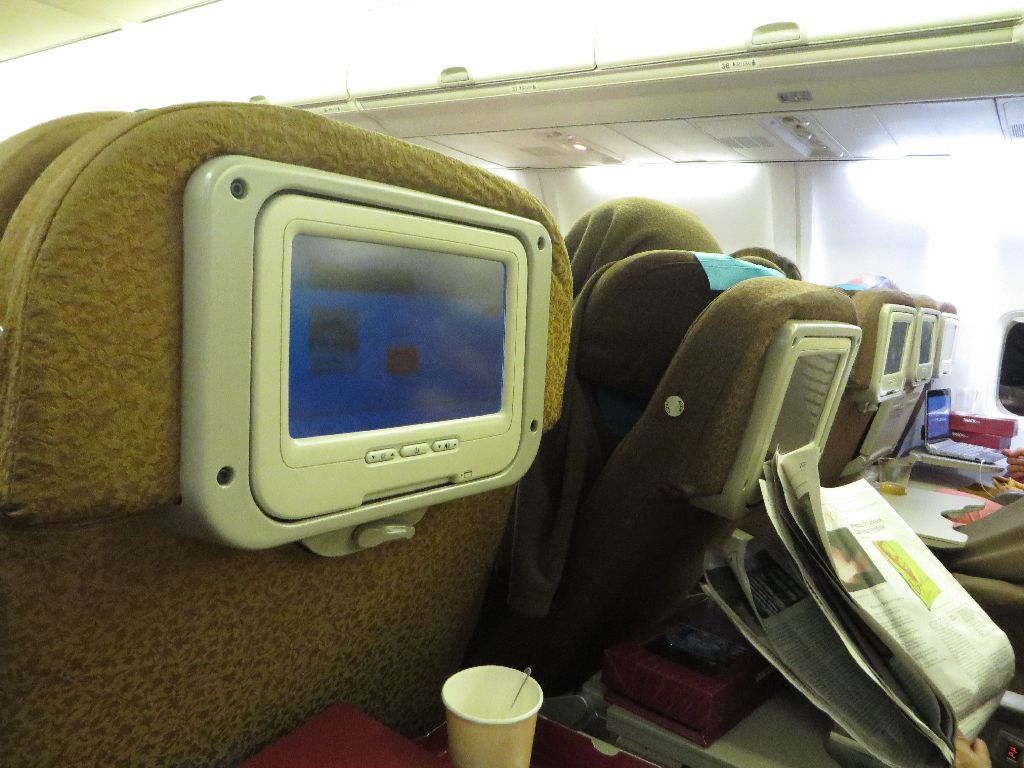
… and note that I am not the only one to chose the burqa option with a blanket (obtained from a FA).
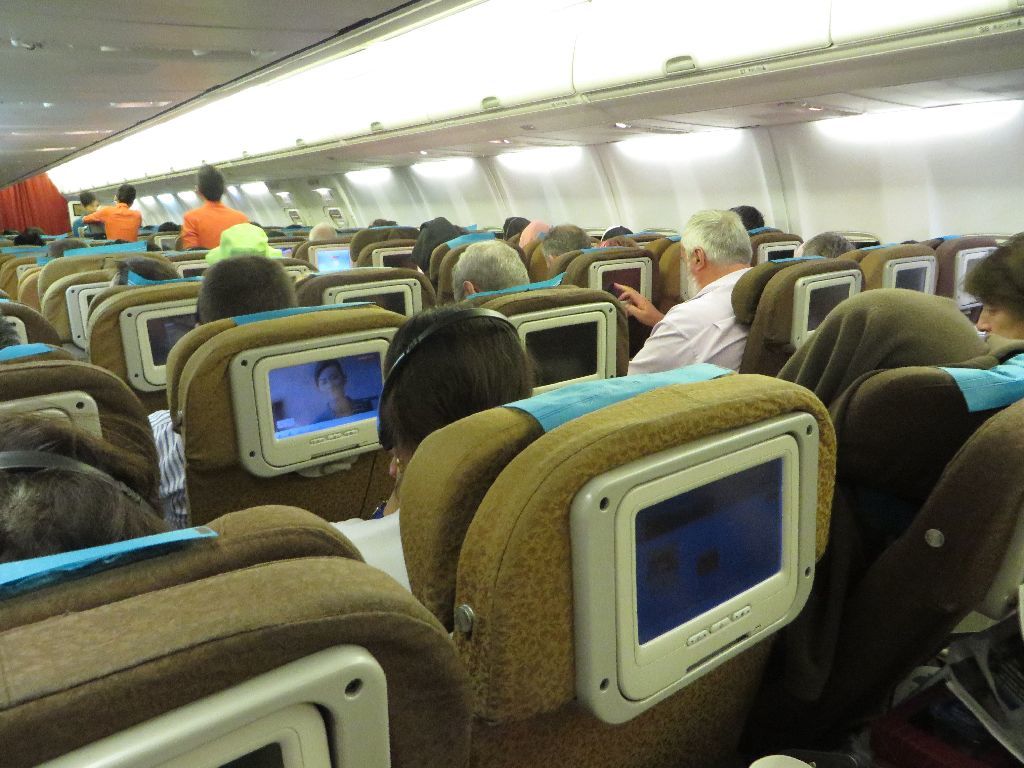
The winglet by night
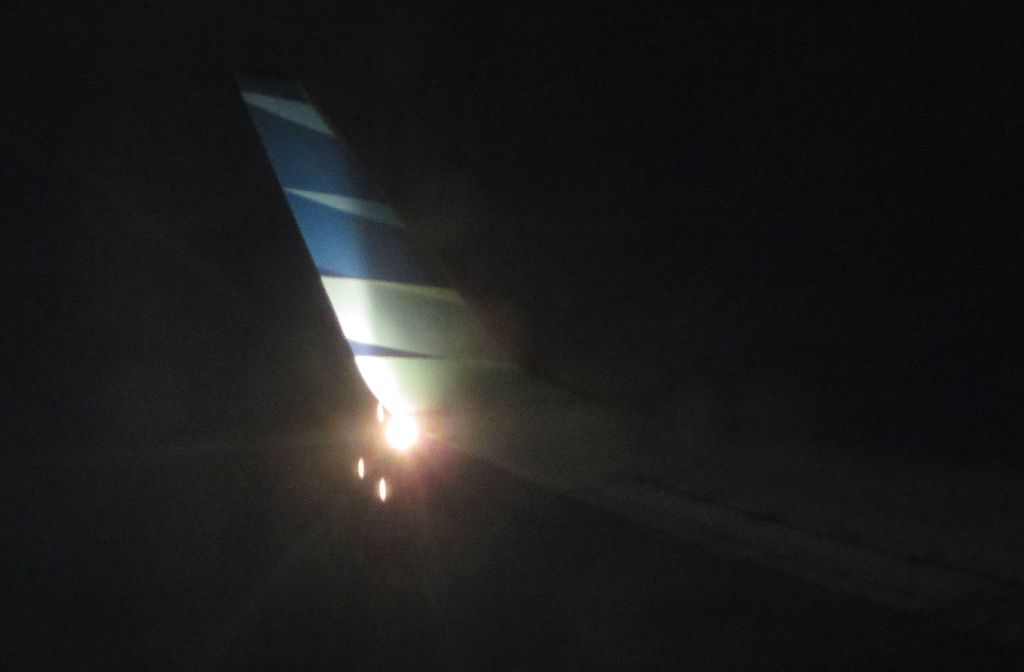
Landing in JOG 25 minutes late. There is a one hour time difference between DPS and JOG, because the limit between the two Indonesian time zones lies in the narrow straits between Java and Bali Islands.
The Indonesians do not mind walking under the wing
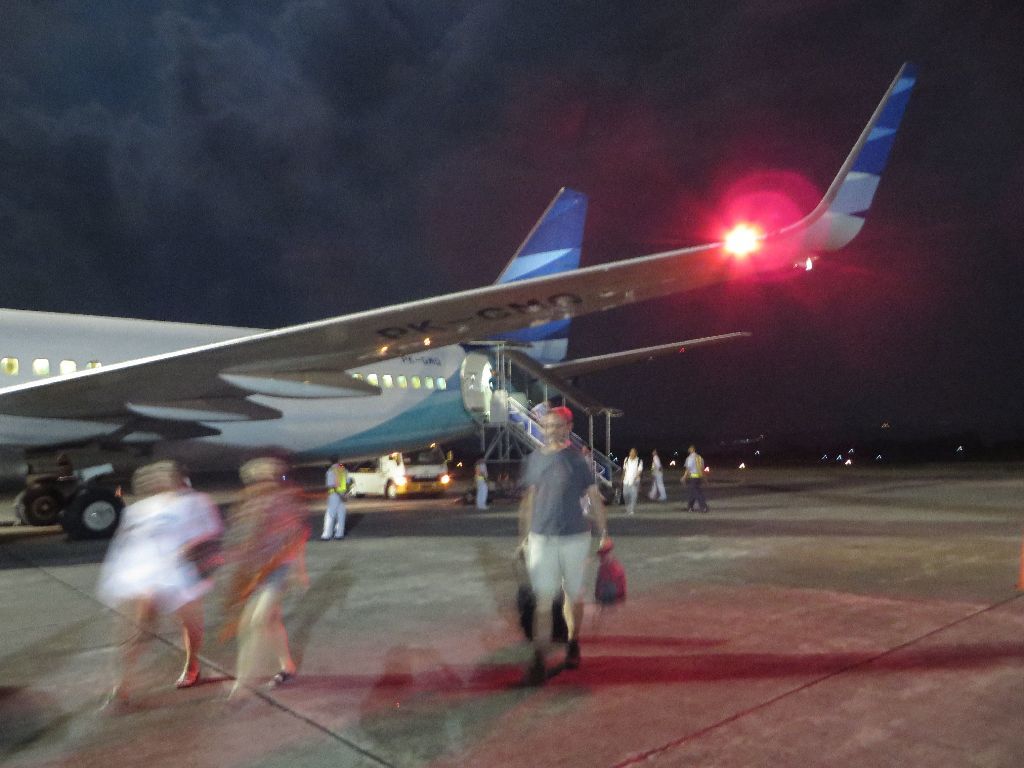
The 738 under the moon light
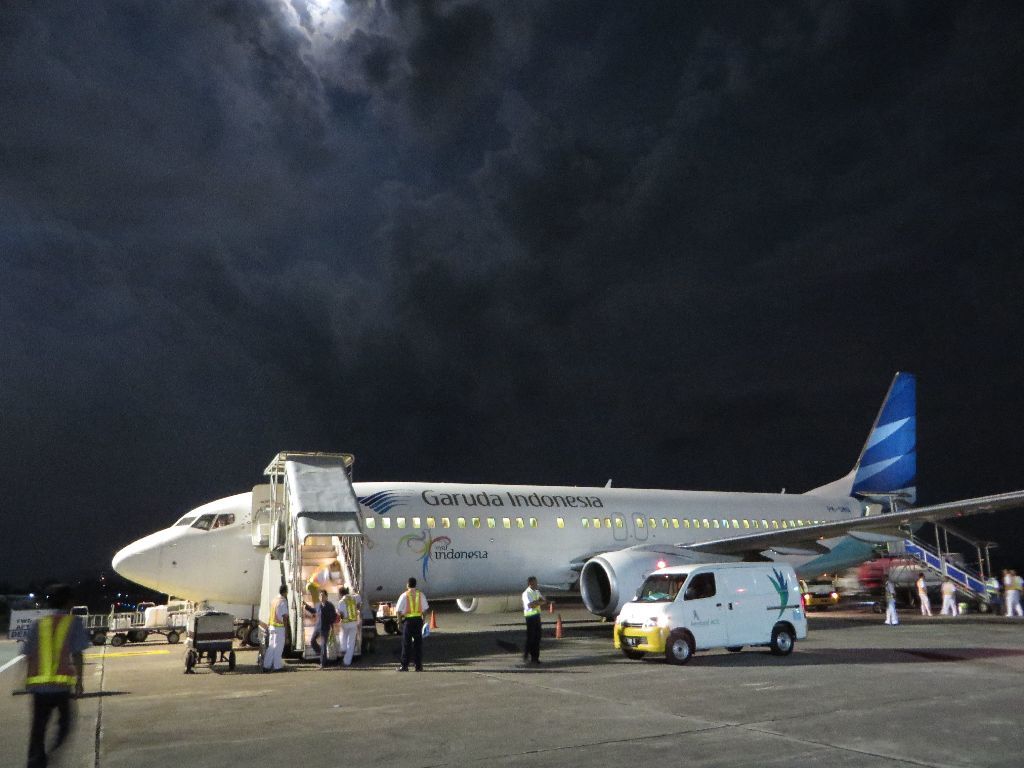
Another GA 738
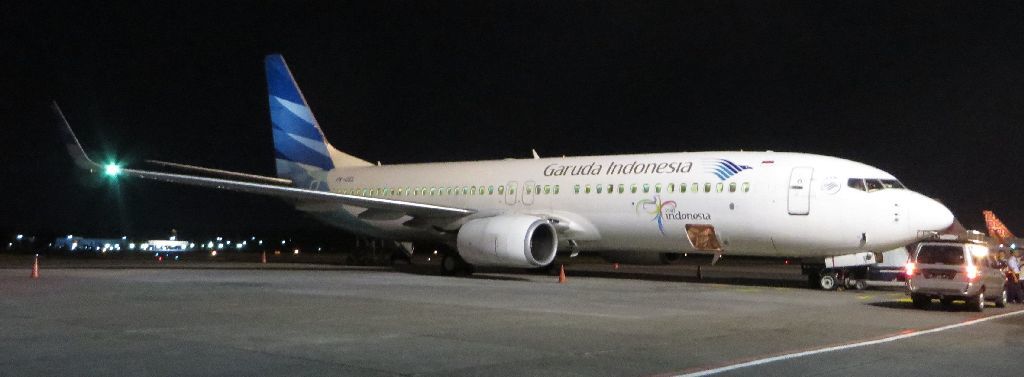
And a 739ER from Lion Air, the largest Indonesian LCC.
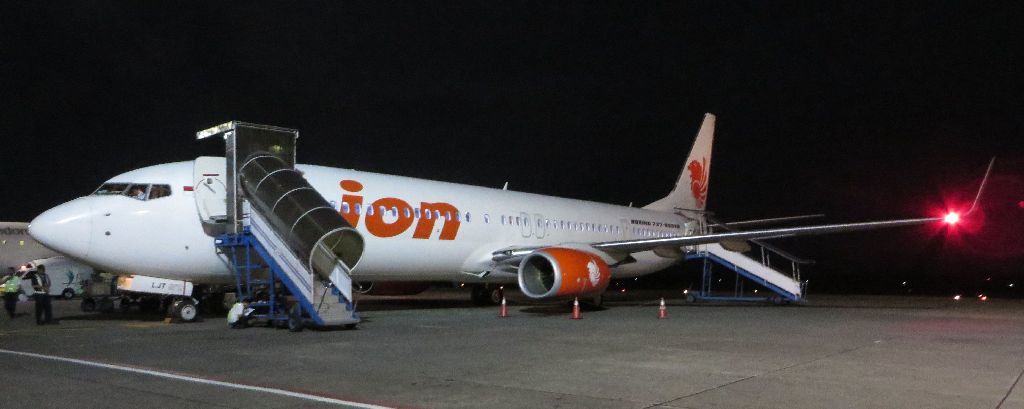
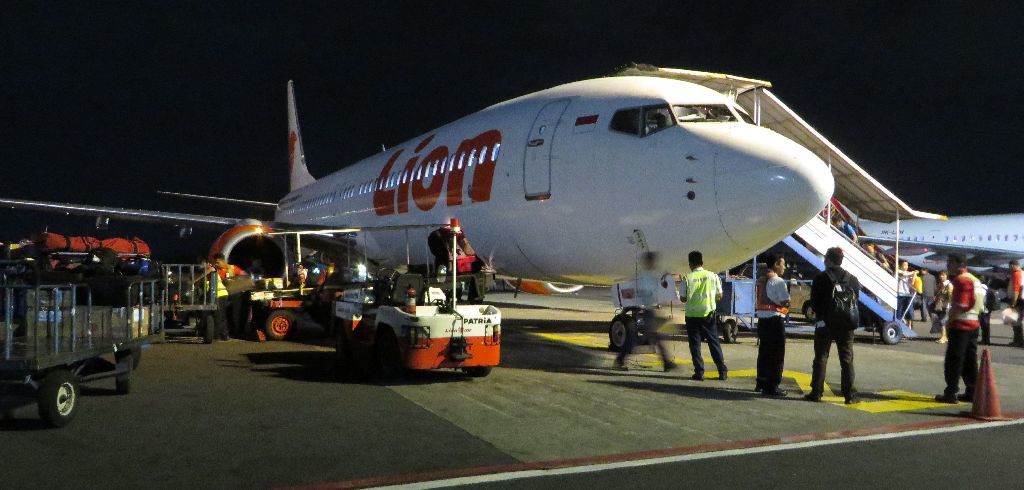
No bus, we walk alongside the terminal.
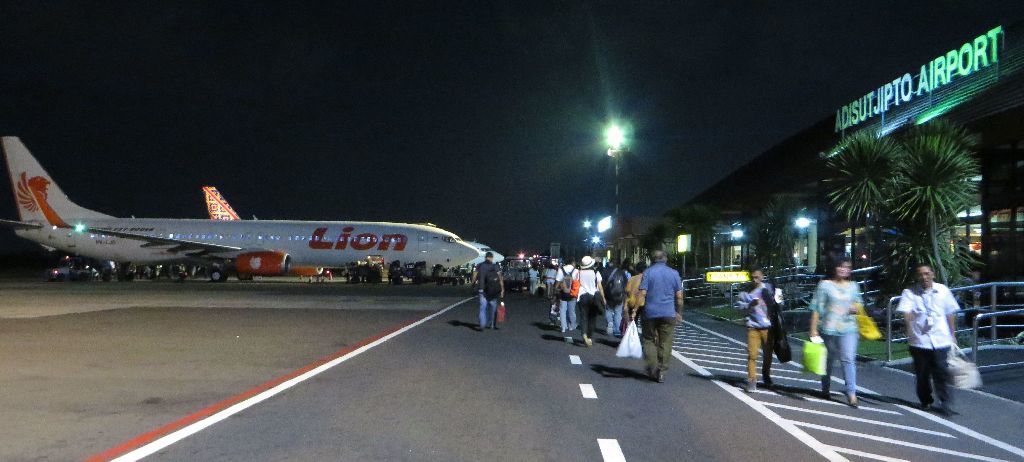
A 739ER of Batik Air, an airline created recently by Lion Air to compete with Garuda in the full service segment. I like the fetching tail decoration better than their fares.
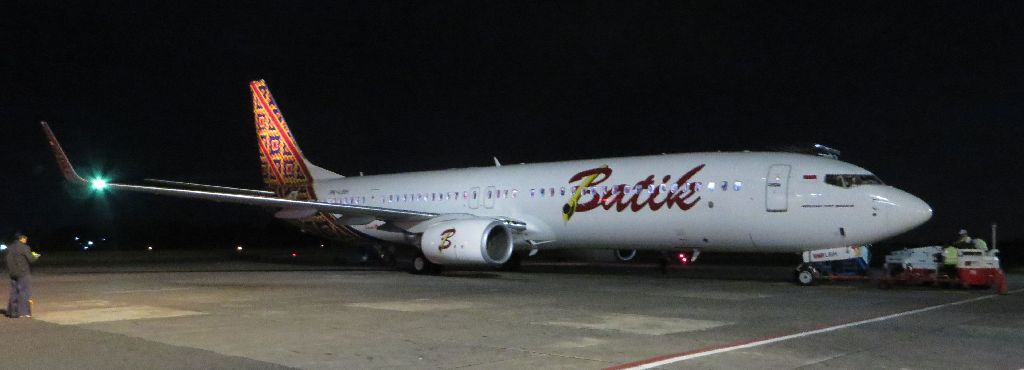
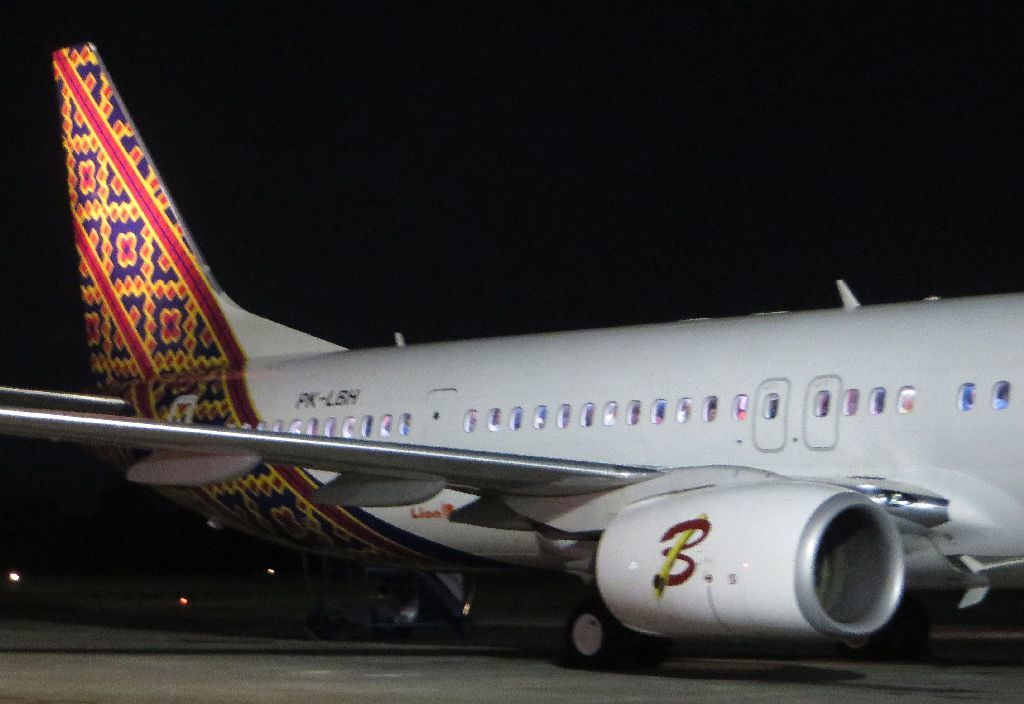
Around twenty minutes wait for our luggage, which seem to be in the last quarter of the delivery, from the number of waiting passengers.
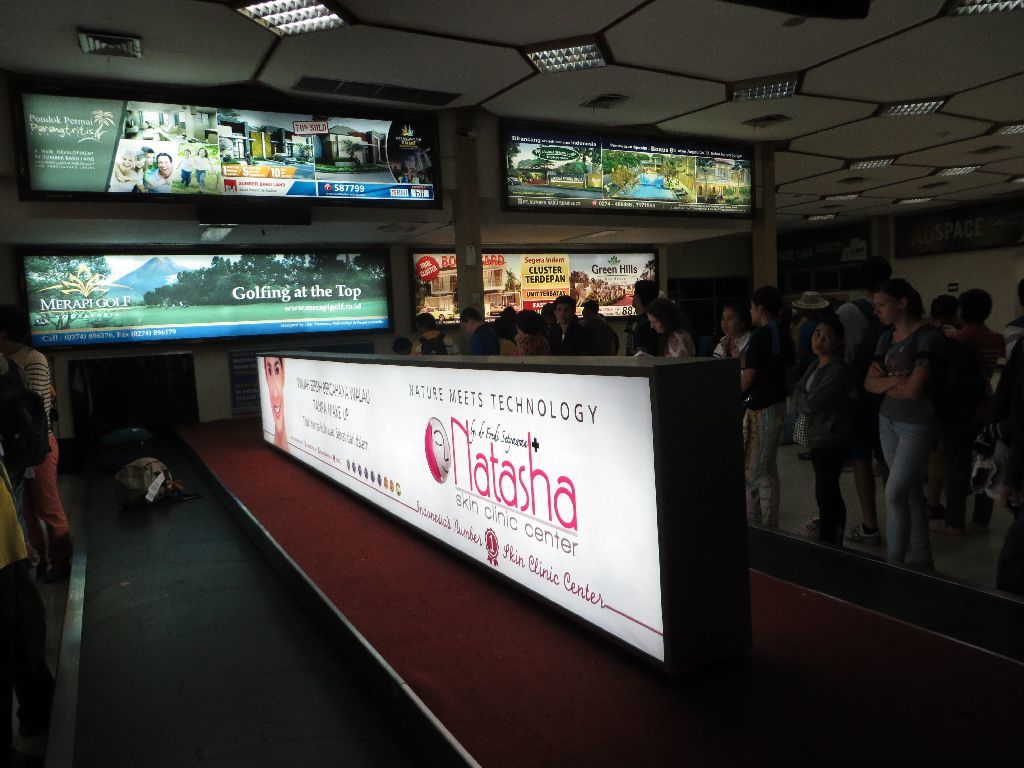
There is a single exchange counter airside, which displays a very unfavorable 14 000 IRD to the euro rate. Fortunately, there are ATMs landside which allow me not to waste my cash which I am going to exchange the next time in the city center in an exchange booth in the narrowest of streets, hardly different from this one…
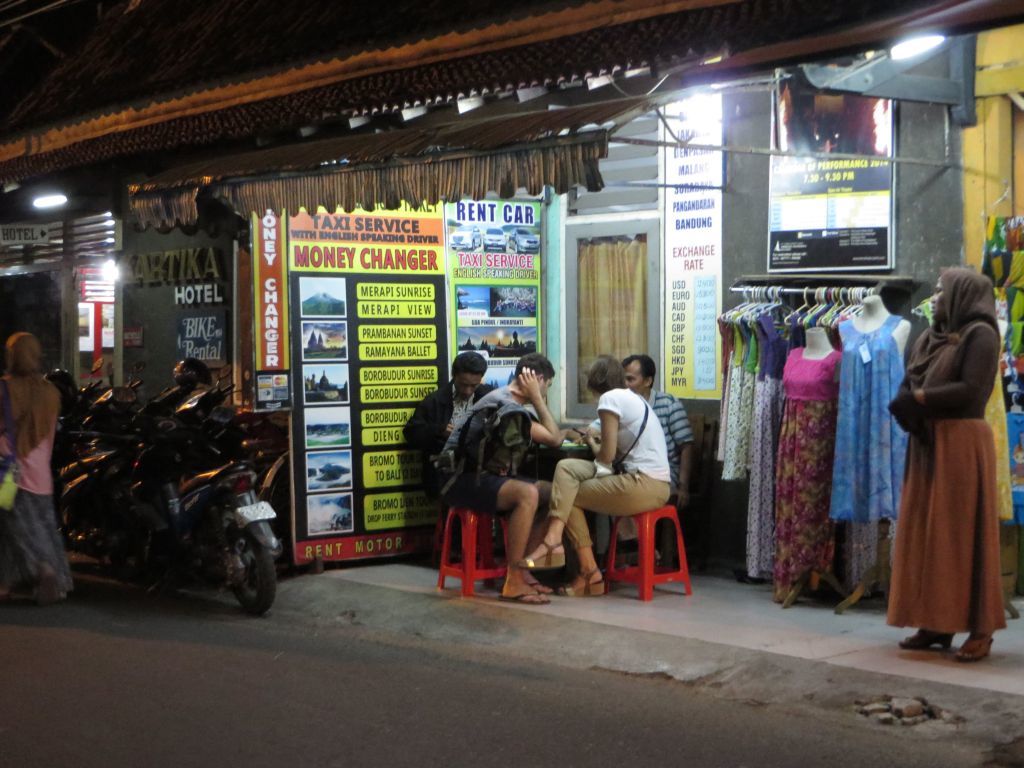
… where the exchange rate is much closer to the official rate
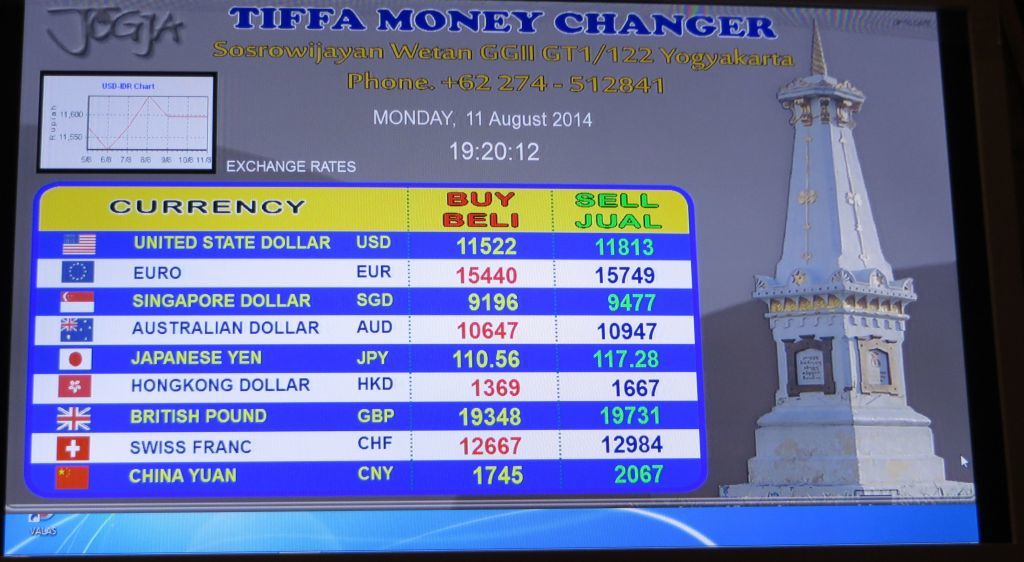
Note that the rate is much less favorable for the Japanese and that the Chinese take a beating, both in HKD and in CNY.
We are not there yet, but at the airport. There are independent taxis, but also a flat rate taxi service : we buy a voucher for a ride to the city center. These vouchers are numbered, so it is strictly first come, first serve.
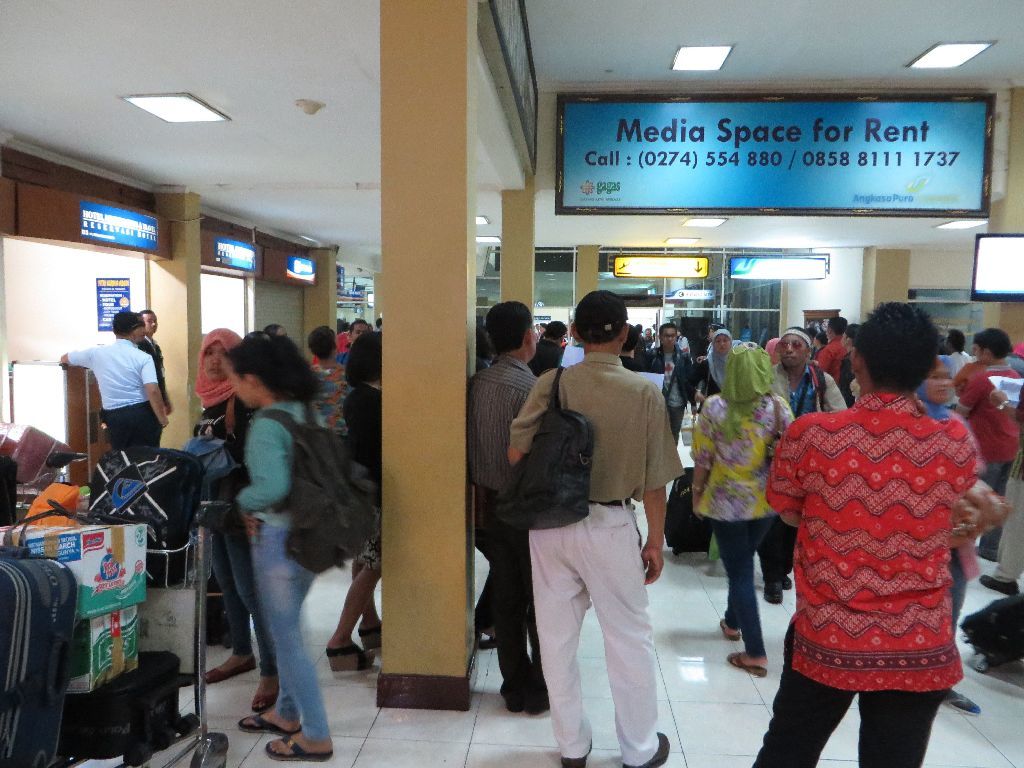
And afterwards, we only need to wait in line, without any bad surprise with regards to the fare of the ride.
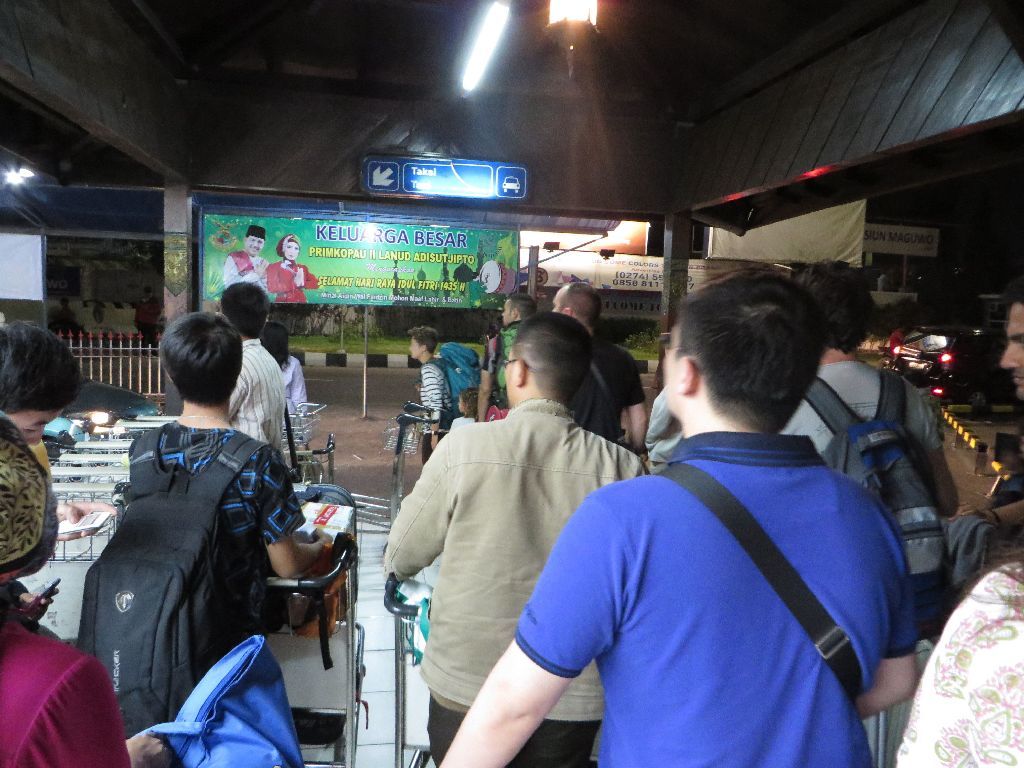
It is 21:30 local time when we reach this hotel room, over thirty hours after leaving our apartment in Paris. Small wonder that it did not take much time to be asleep!
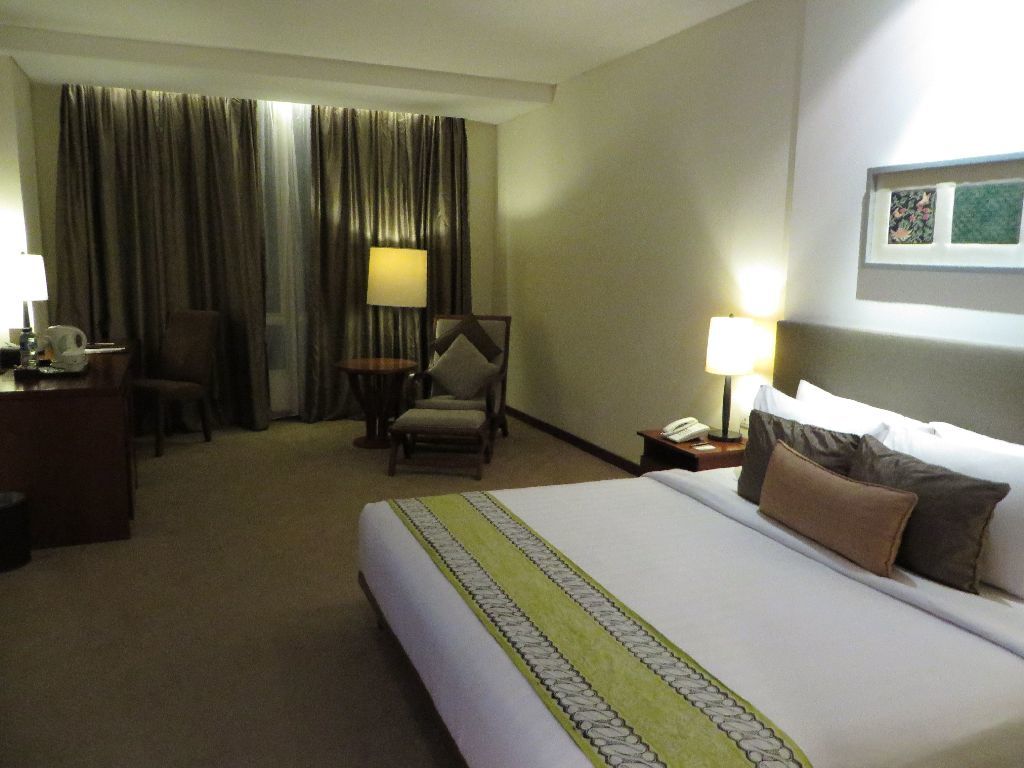
If you are not as exhausted as I as was at this stage, you should be able to endure a local tourist bonus which I did not manage to abridge, because there is so much to be said about Yogyakarta. If you don't, simply jump to the conclusion.
Let's start with the gamelan, an orchestra with traditional instruments and singers
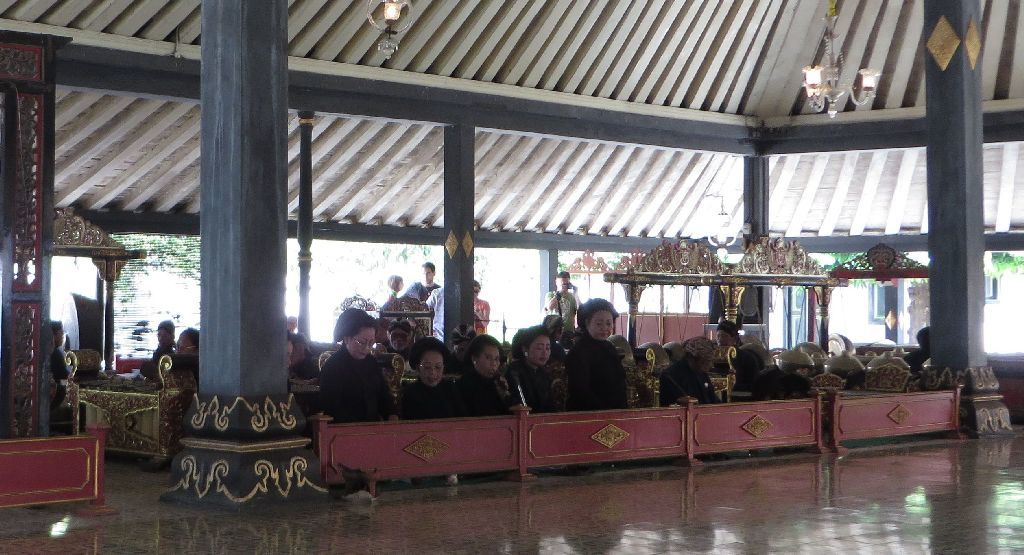
Classic music lovers and fans of rack alike, Westerners are likely to be surprised by the layout in rows of the musicians, some being back to back to each other.
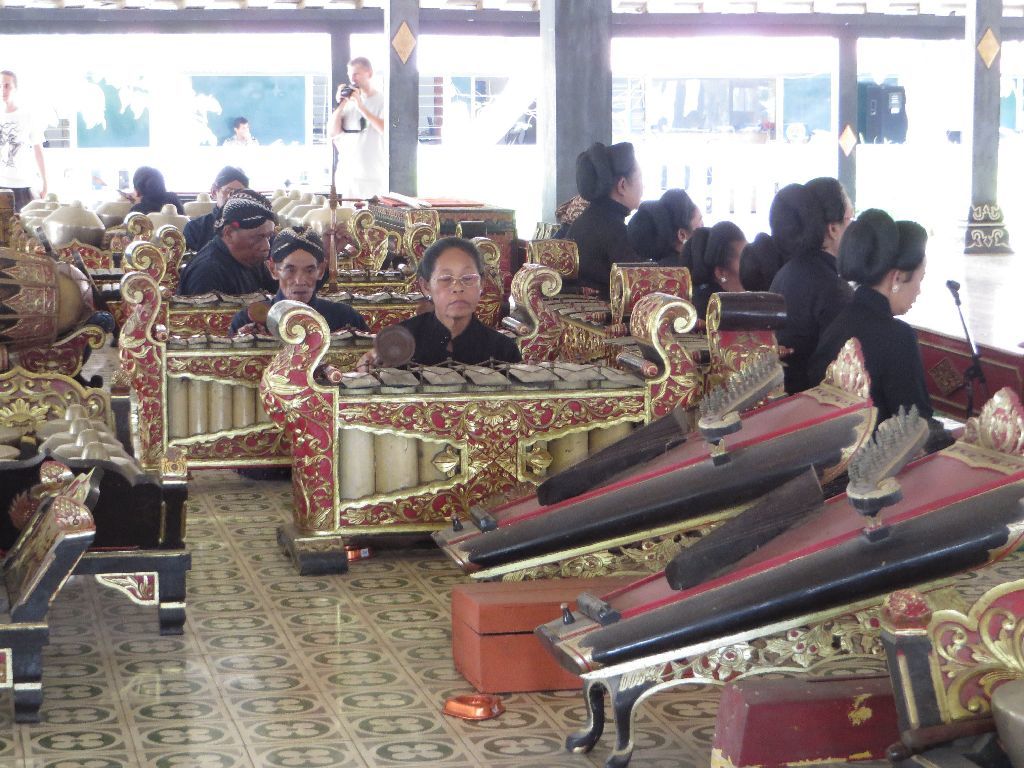
The result may seem like an endless and unstructured litany, which it is not: there are music scores, with a numbered transcription system like the one used in China and Taiwan.
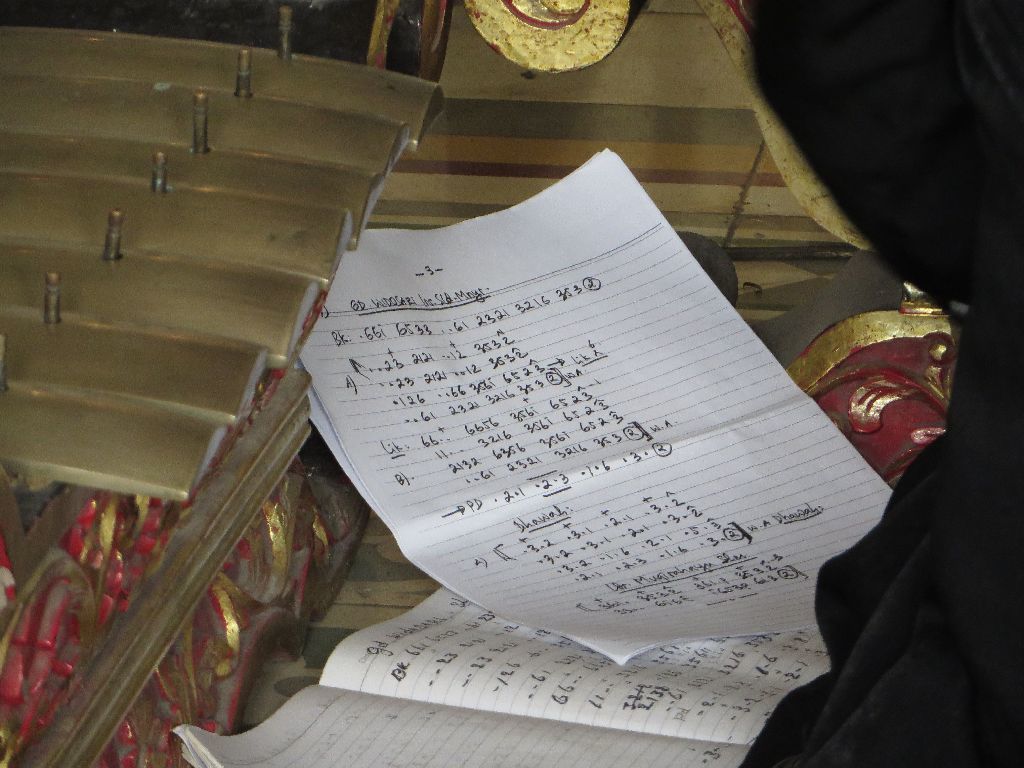
The gamelan is the perennial musical backdrop of Indonesian performing arts, which are often based on the Ramayana, this central tale of the Hindu culture. This is the case of the wayang kulit, or shadow theatre, where the show is on both sides of the screen :
backstage with the gamelan and the puppet player,
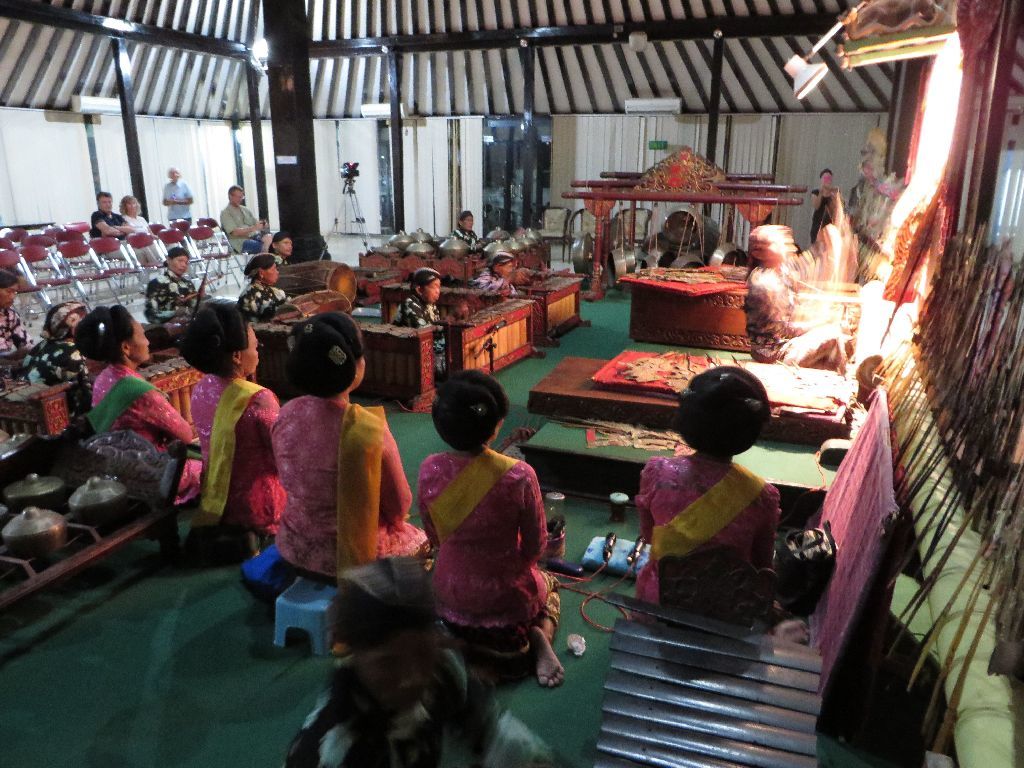
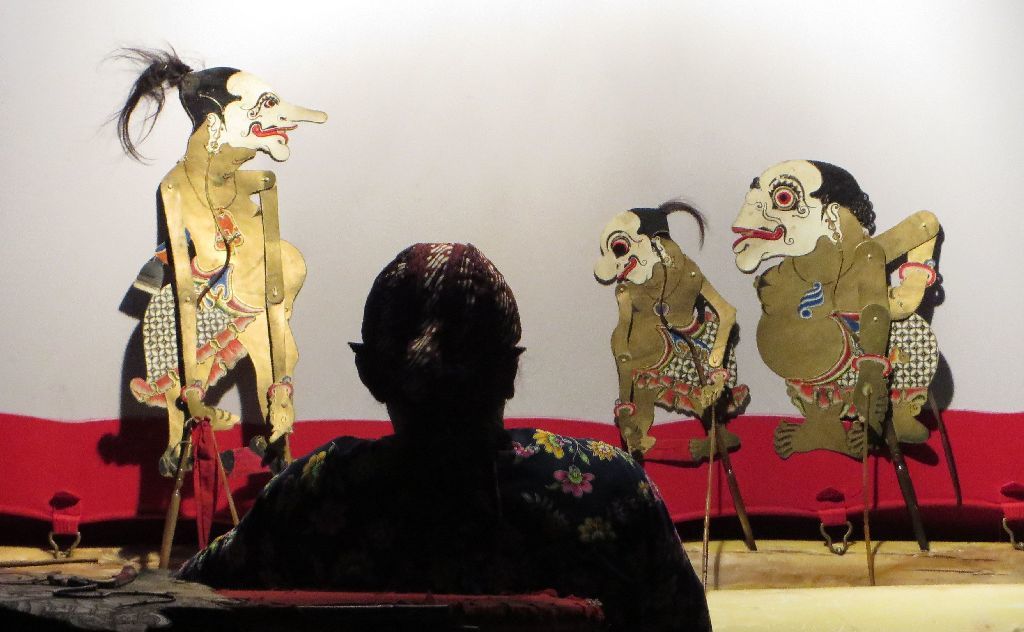
… and front stage, with the resulting shadows
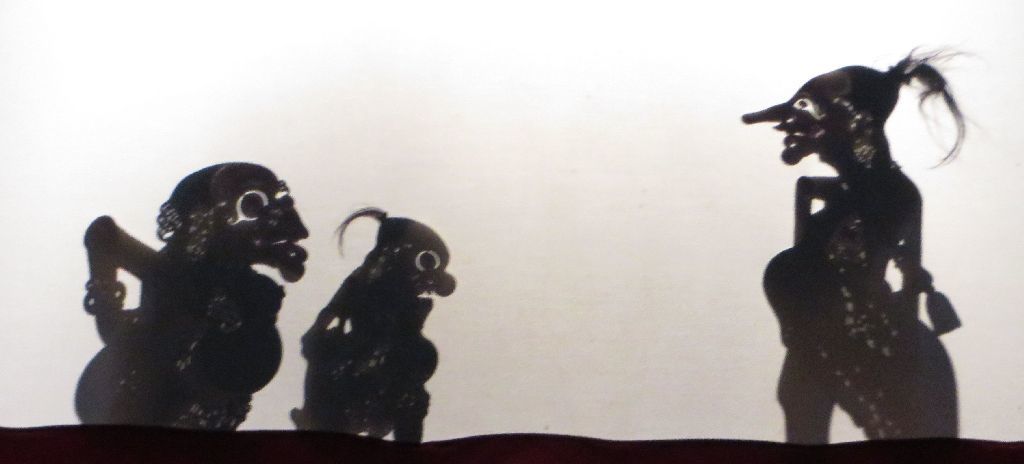
The best is to be able to move around and see both sides as we did. This two hour show only covered one of the twelve episodes of the Ramayana, which tells a lot on the effort of synthesis of the ballet at Prambanan, which managed to cover the entire tale in a two hour show. A few key scenes:
Disguised as a Brahmin, Wakhana lures Sita out of her protective magic circle in order to kidnap her.
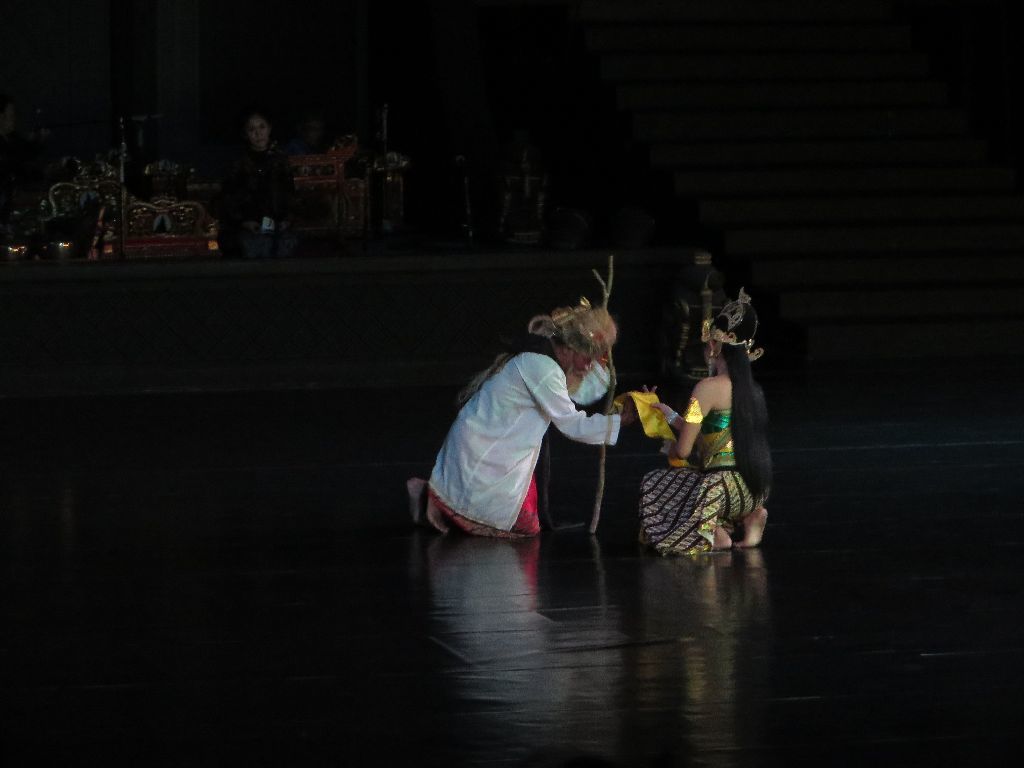
Hanuman reaches Sita
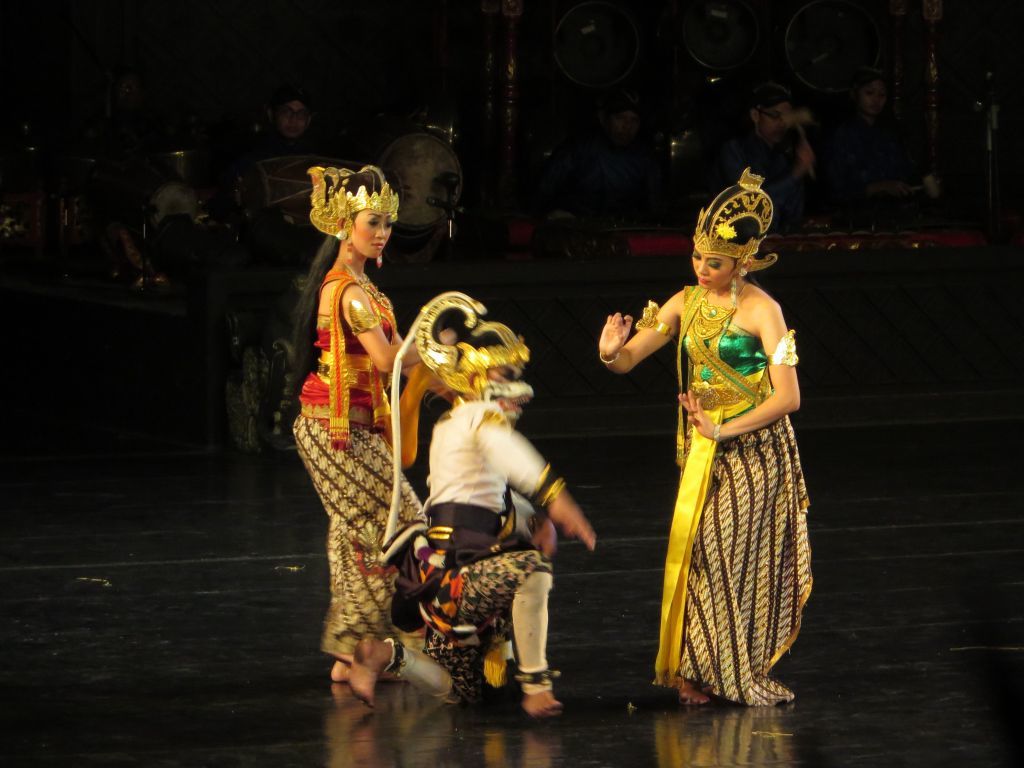
Hanuman sets fire to Wakhana's palace with his magic powers
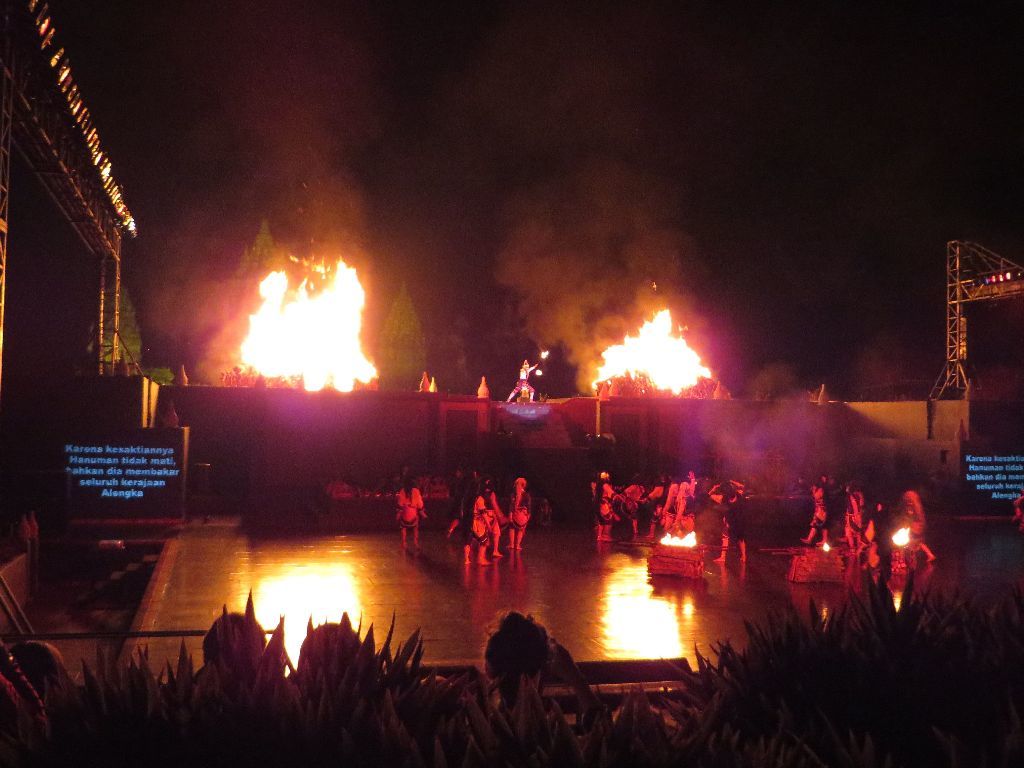
The monkeys' army creates a bridge above the sea
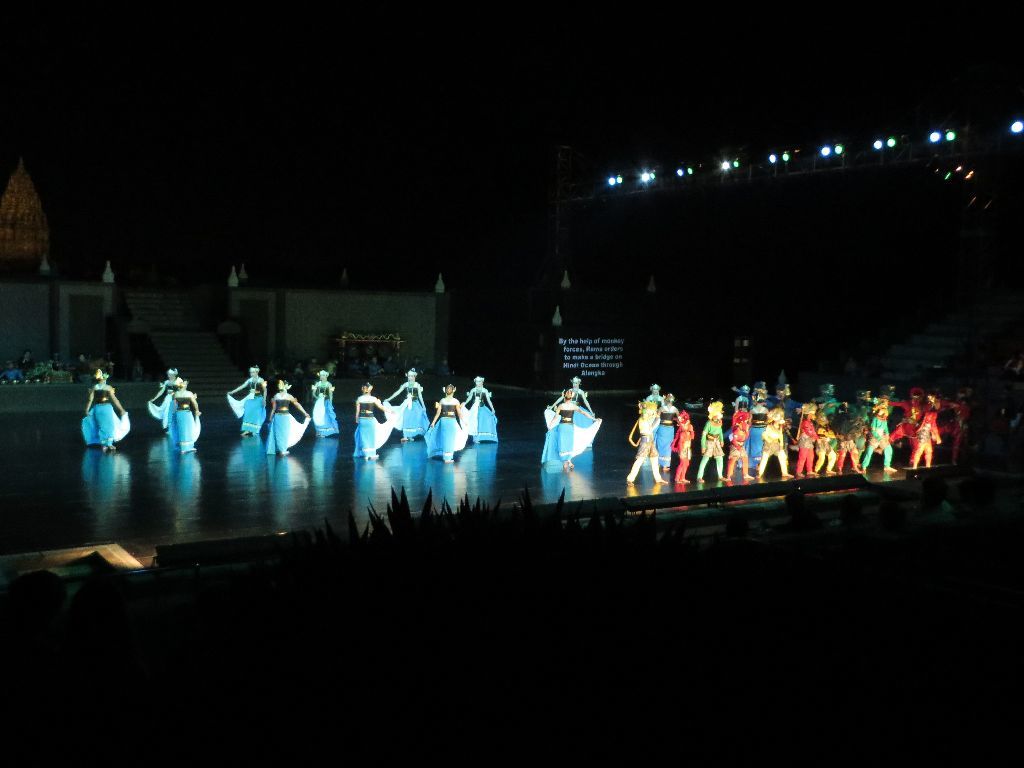
Sita proves her purity in submitting herself to fire
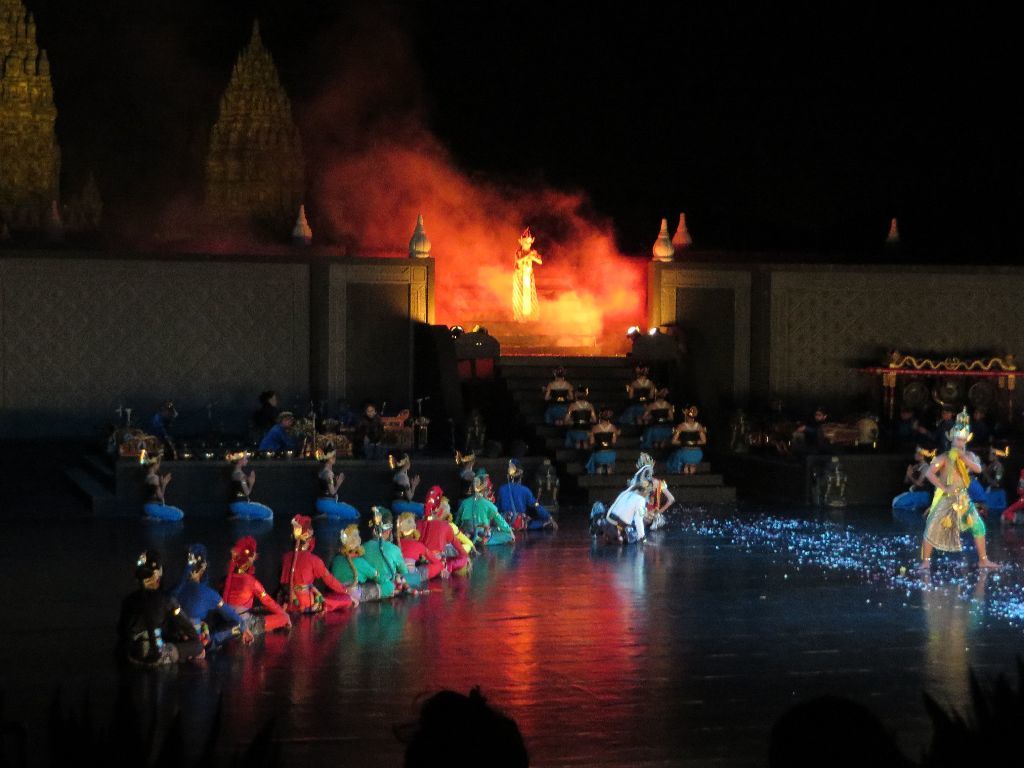
But how can I compare this two hour show to Prambanan temple, despite the fact that less than ten percent of its ruins have been rebuilt?
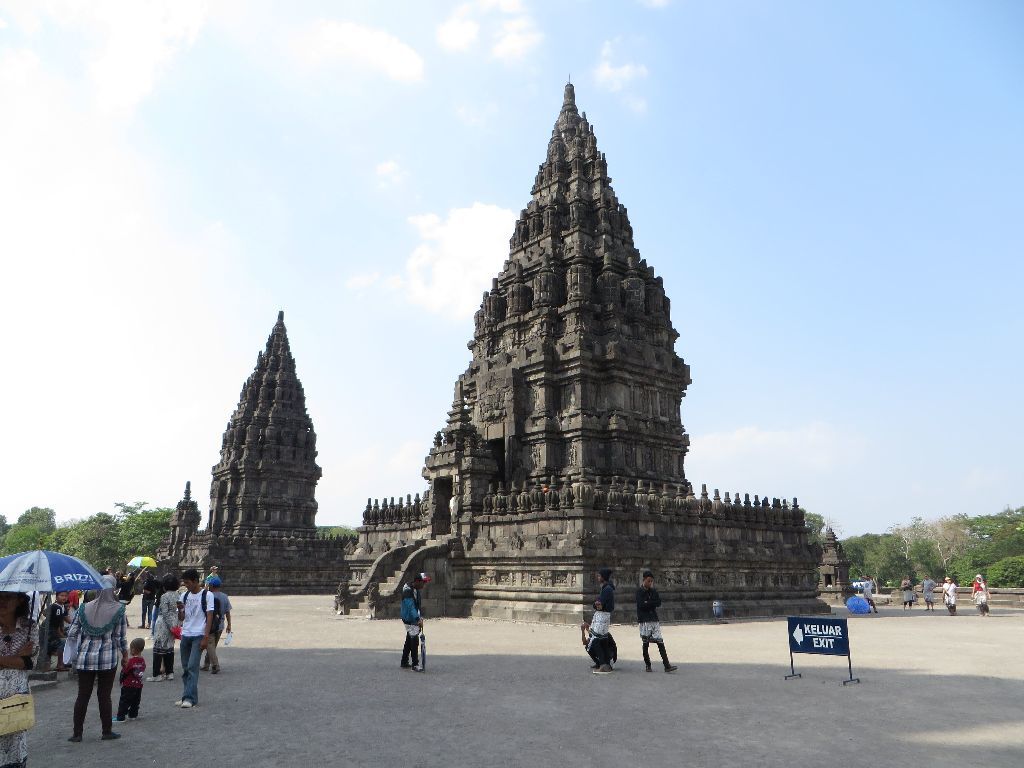
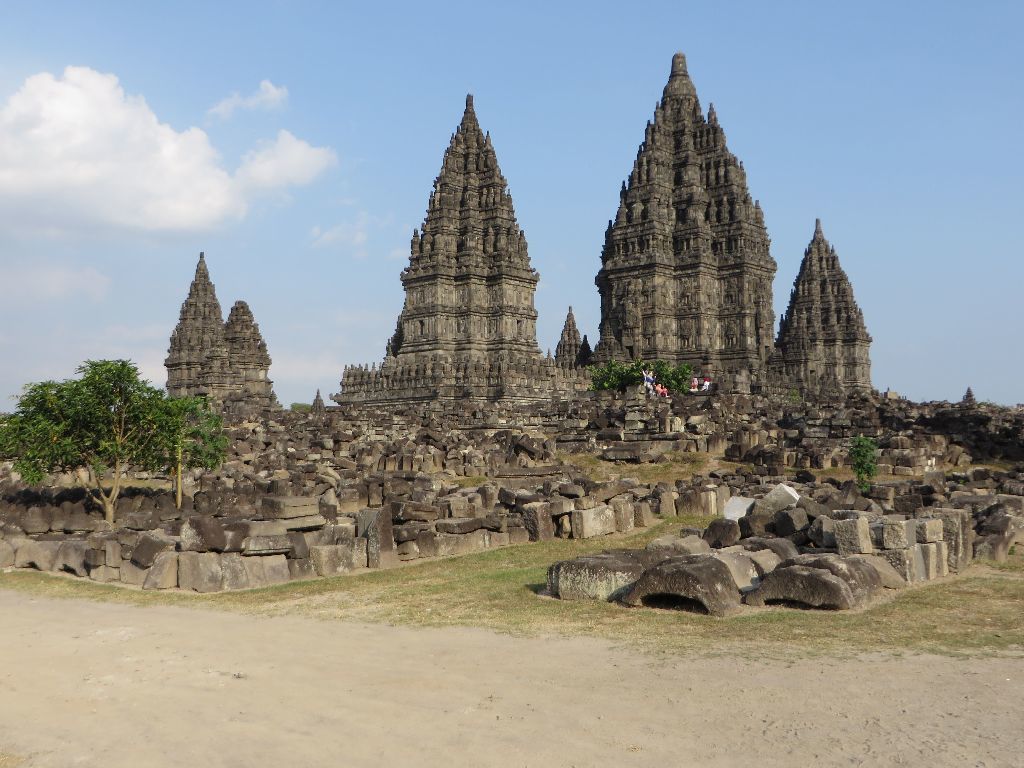
Realize that these gigantic monuments are entirely covered with stone sculptures and bas-reliefs, inspired in part from the Ramayana.
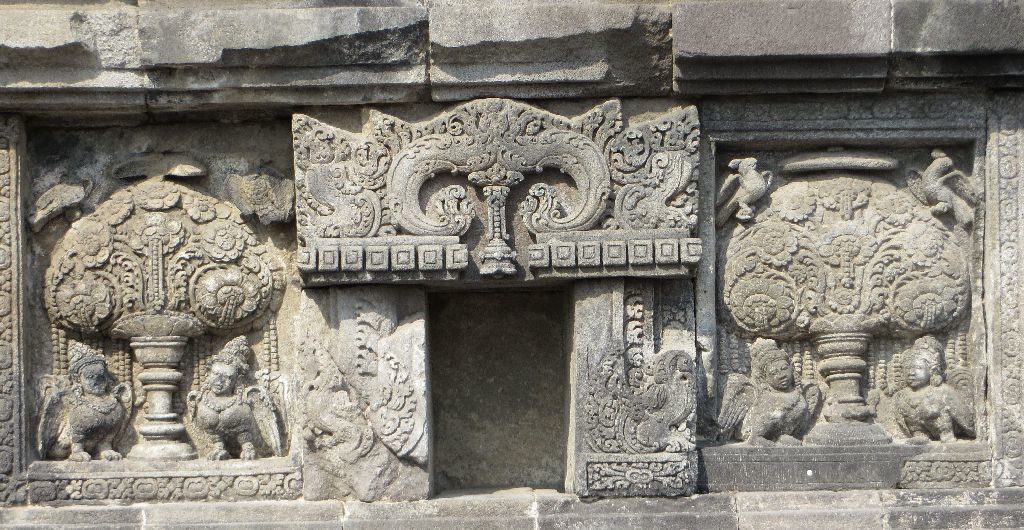
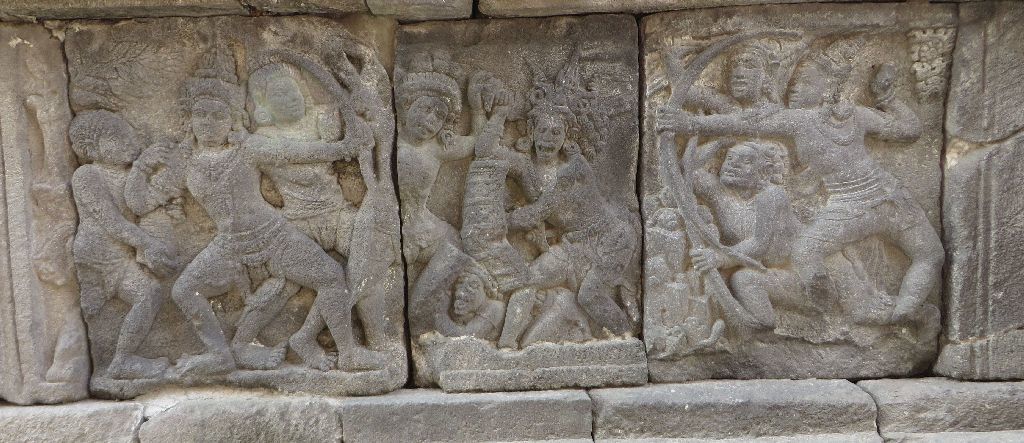
But however impressive can Prambanan temple be, how could it compare with Borobudur temple, which is so huge that I never had the impression of crowds of visitors, even though this is the most visited site in Indonesia?
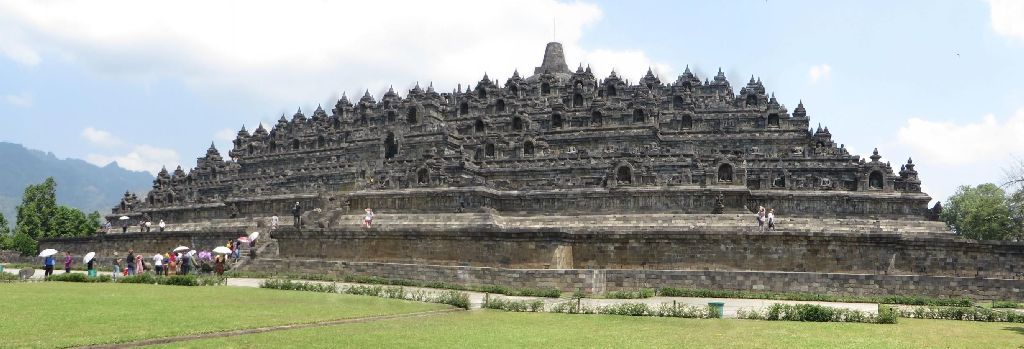
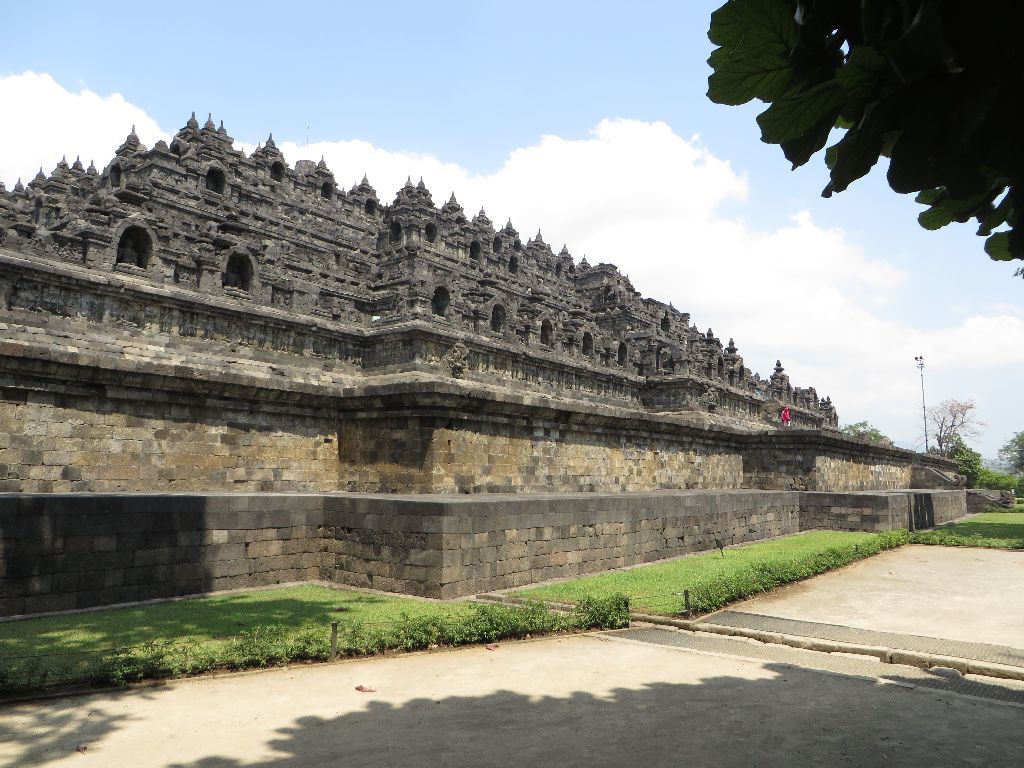
With its bas-reliefs sculpted on both sides of its five kilometers of corridors on six levels circling the temple ?
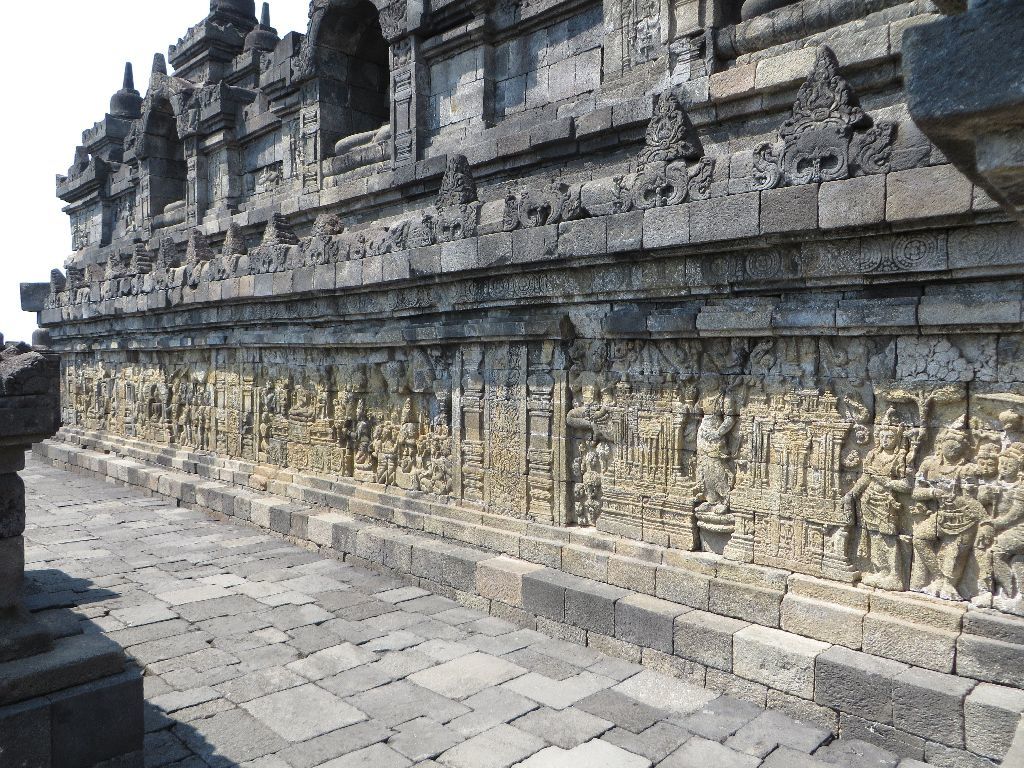
They are inspired by the Ramayana, and also by the life of Buddha, beginning here by the premonitory dream of an elephant by the queen, announcing the future birth of Siddhartha
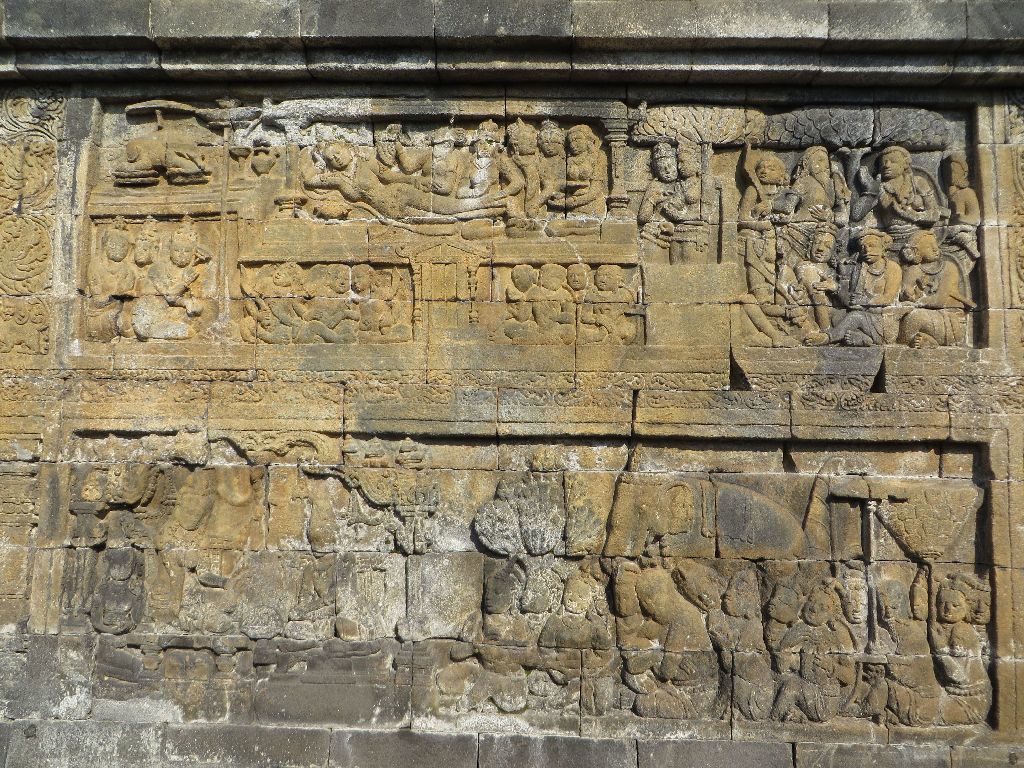
Buddha changing his enemies' arrows into flowers
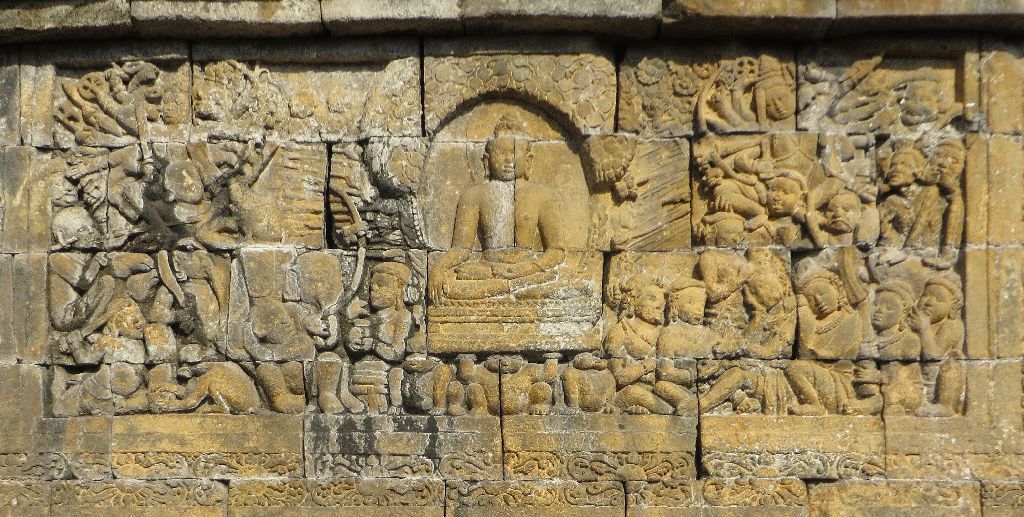
The tale of the lion of the bird (Be happy that I did not eat you, roars the lion when the bird which removed a painful stick in the lion's mouth asks a reward).
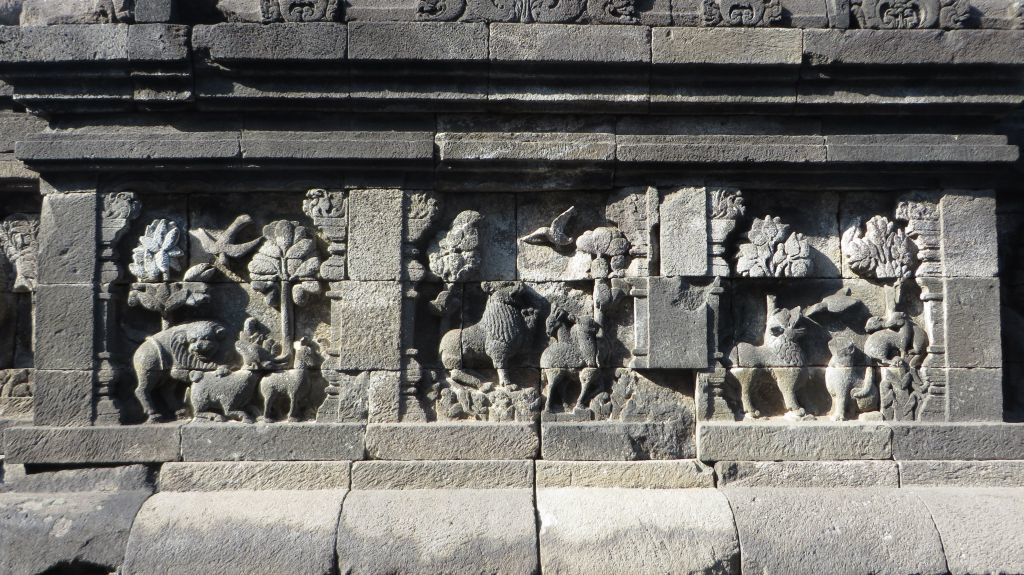
Buddha in the shape of a tortoise, saving sailors from drowning (providing a valuable image of a ship of that time)
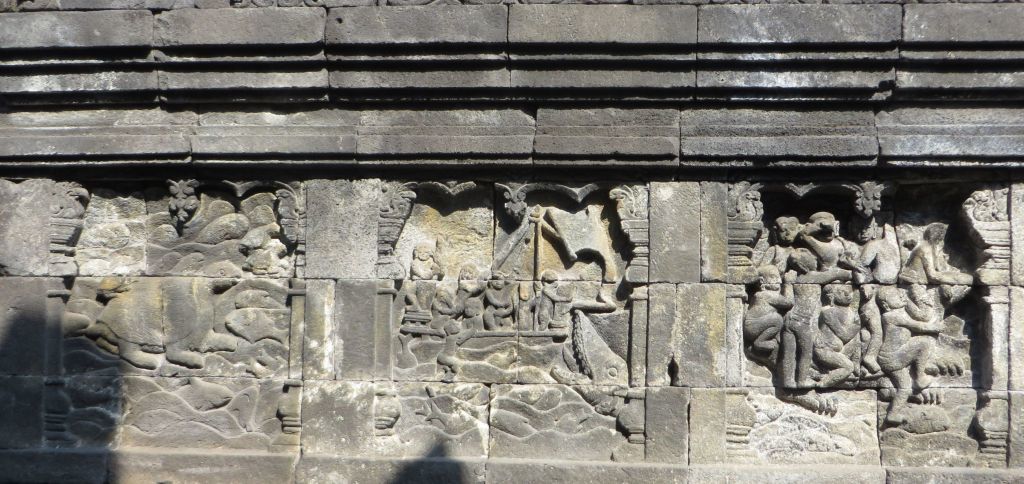
At the upper level, openwork stupas surround a solid stupa
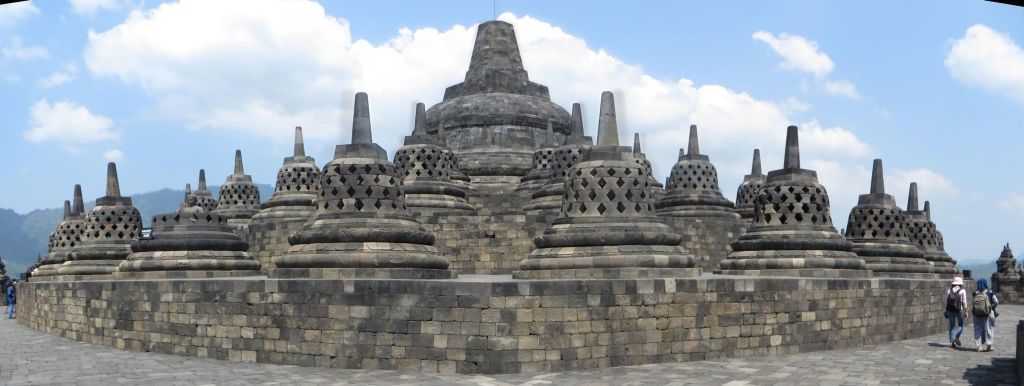
One of the statues of Buddha in the openwork stupas
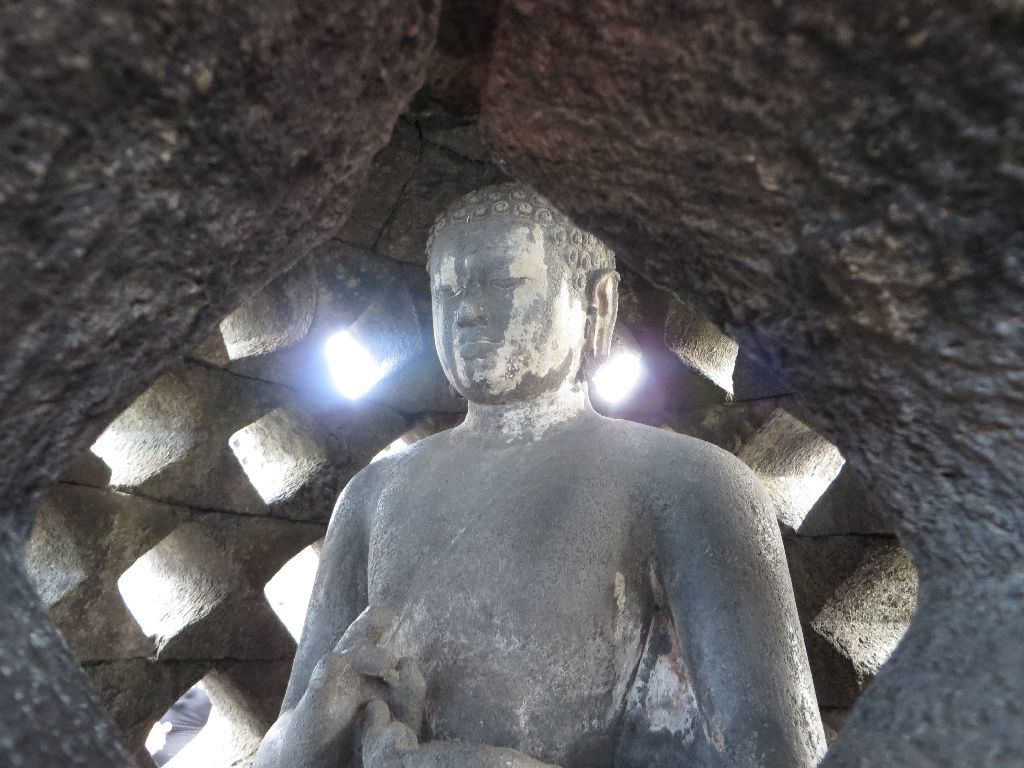
The Buddha statue in the incomplete stupa at sunset
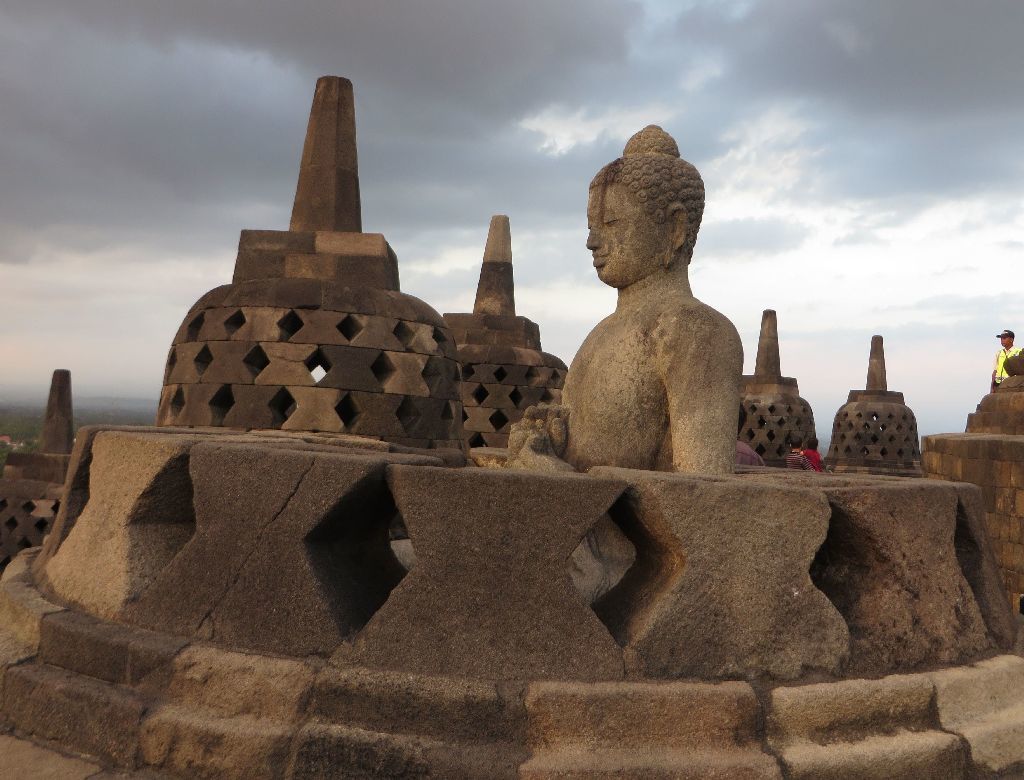
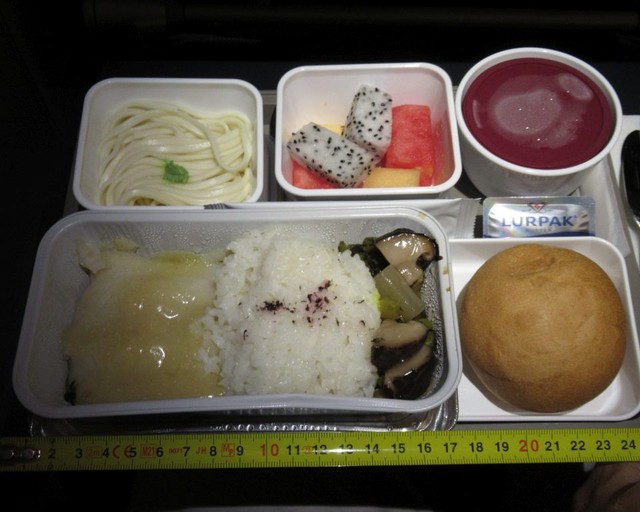
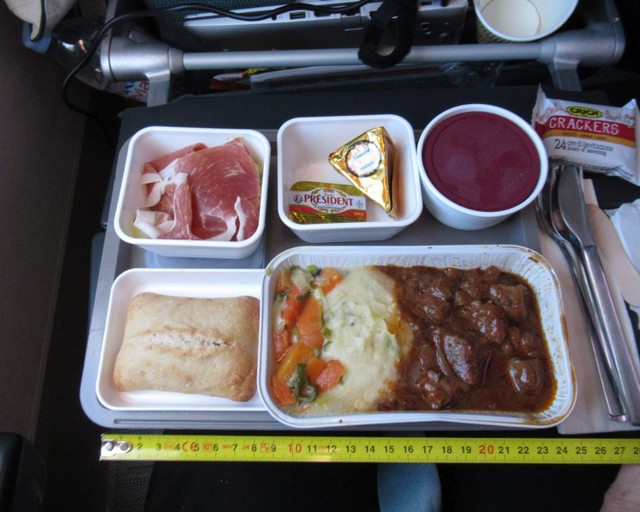
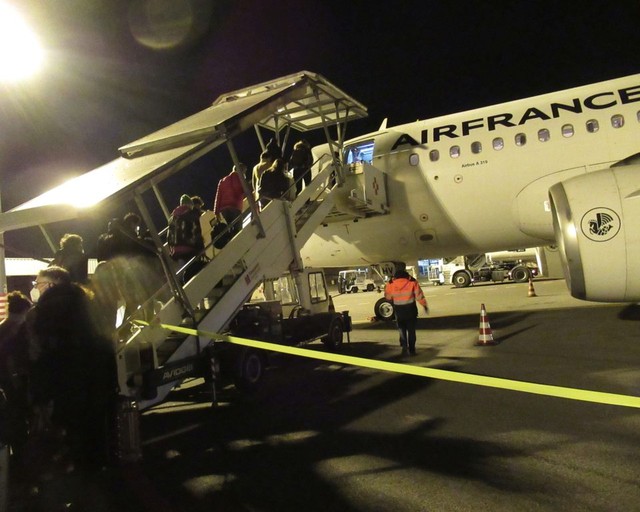
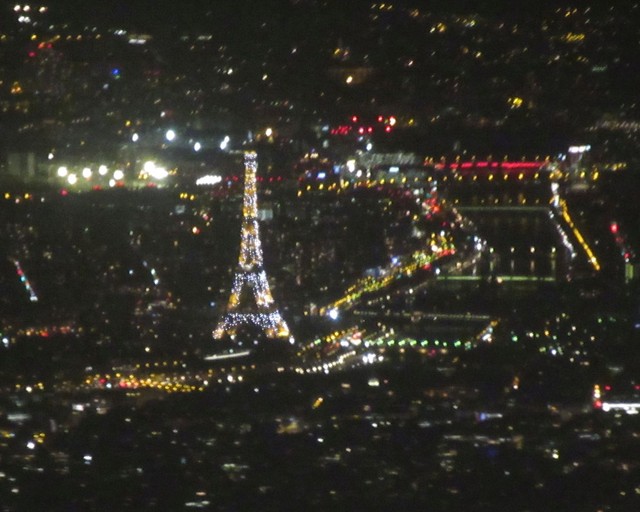
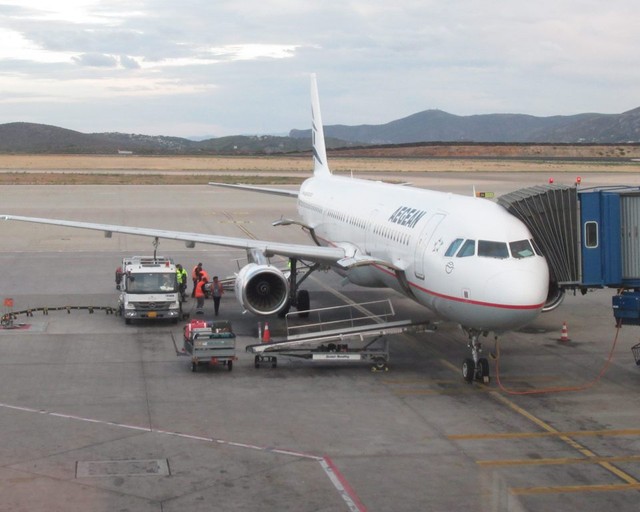
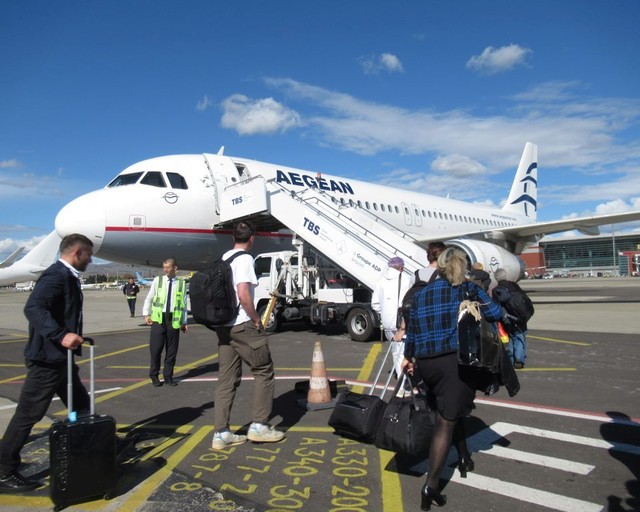

Another fine report in this series. Thanks for the beautiful bonus with the architectural sights.
GA seems to be a great carrier and it's amazing to see an attempt to provide decent catering for a short domestic flight. What a contrast to U.S. flights like ATL or ORD-HNL that do not even offer peanuts with your beverages, especially these days when the industry has been consolidated into a handful of carries and they are showing profits.
What strikes me is that the reduction or suppression of food provided by legacy airlines and LCC has not generated a boxed lunch business in the airports. Sadly, once airside, we only find luxury goods and junk food, whereas you can buy a healthy, cheap, convenient and quintessentially Japanese bent? (??) in any Japanese train station, often on the platform a few meters from the train that you will board.
Thanks for your comment !